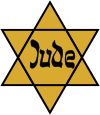Neo-Nazism
Neo-Nazism consists of post-World War II militant, social or political movements seeking to revive and implement the ideology of Nazism. Neo-Nazis seek to employ their ideology to promote hatred and attack minorities, or in some cases to create a fascist state.[1][2]
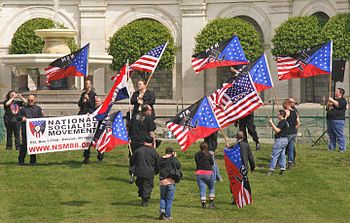
| Terrorism | |||||||
|---|---|---|---|---|---|---|---|
| |||||||
|
By ideology
|
|||||||
|
Structure |
|||||||
|
|||||||
|
Terrorist groups |
|||||||
|
Adherents |
|||||||
|
Response to terrorism
|
|||||||
Neo-Nazism is a global phenomenon, with organized representation in many countries and international networks. It borrows elements from Nazi doctrine, including ultranationalism, racism, xenophobia, ableism, homophobia, anti-Romanyism, antisemitism, anti-communism and initiating the Fourth Reich. Also, Holocaust denial is a common feature espoused by neo-Nazis.
Neo-Nazis regularly display Nazi symbols and express admiration for Adolf Hitler and other Nazis.
In some European and Latin American countries, laws prohibit the expression of pro-Nazi, racist, anti-semitic, or homophobic views. Many Nazi-related symbols are banned in European countries (especially Germany) in an effort to curtail neo-Nazism.[3]
Definition
The term neo-Nazism describes any post-World War II militant, social or political movements seeking to revive the ideology of Nazism in whole or in part.[4][5]
The term neo-Nazism can also refer to the ideology of these movements, which may borrow elements from Nazi doctrine, including ultranationalism, anti-communism, racism, ableism, xenophobia, homophobia, anti-Romanyism, antisemitism, up to initiating the Fourth Reich. Holocaust denial is a common feature, as is the incorporation of Nazi symbols and admiration of Adolf Hitler.
Neo-Nazism is considered a particular form of far-right politics and right-wing extremism.[6]
Hyperborean racial doctrine
Neo-Nazi writers have posited a spiritual, esoteric doctrine of race, which moves beyond the primarily Darwinian-inspired materialist scientific racism popular mainly in the Anglosphere during the 20th century. Figures influential in the development of neo-Nazi racism, such as Miguel Serrano and Julius Evola (writers who are described by critics of Nazism such as the Southern Poverty Law Center as influential within what it presents as parts of "the bizarre fringes of National Socialism, past and present"),[7] claim that the Hyperborean ancestors of the Aryans were in the distant past, far higher beings than their current state, having suffered from "involution" due to mixing with the "Telluric" peoples; supposed creations of the Demiurge. Within this theory, if the "Aryans" are to return to the Golden Age of the distant past, they need to awaken the memory of the blood. An extraterrestrial origin of the Hyperboreans is often claimed. These theories draw influence from Gnosticism and Tantrism, building on the work of the Ahnenerbe. Within this racist theory, Jews are held up as the antithesis of nobility, purity and beauty.
Ecology and environmentalism
Neo-Nazism generally aligns itself with a blood and soil variation of environmentalism, which has themes in common with deep ecology, the organic movement and animal protectionism.[8][9] This tendency, sometimes called "ecofascism", was represented in the original German National Socialism by Richard Walther Darré who was the Reichsminister of Food from 1933 until 1942.[10]
History
Germany and Austria, 1945–1950s
Following the defeat of Nazi Germany, the political ideology of the ruling party, Nazism, was in complete disarray. The final leader of the National Socialist German Workers' Party (NSDAP) was Martin Bormann. He died on 2 May 1945 during the Battle of Berlin, but the Soviet Union did not reveal his death to the rest of the world, and his ultimate fate remained a mystery for many years. Conspiracy theories emerged about Hitler himself, that he had secretly survived the war and fled to South America or elsewhere.
The Allied Control Council officially dissolved the NSDAP on 10 October 1945, marking the end of "Old" National Socialism. A process of denazification began, and the Nuremberg trials took place, where many major leaders and ideologues were condemned to death by October 1946, others committed suicide.
In both the East and West, surviving ex-party members and military veterans assimilated to the new reality and had no interest in constructing a "neo-Nazism." However, during the 1949 West German elections a number of Nazi advocates such as Fritz Rössler had infiltrated the national conservative Deutsche Rechtspartei, which had 5 members elected. Rössler and others left to found the more radical Socialist Reich Party (SRP) under Otto Ernst Remer. At the onset of the Cold War, the SRP favoured the Soviet Union over the United States.
In Austria, national independence had been restored, and the Verbotsgesetz 1947 explicitly criminalised the NSDAP and any attempt at restoration. West Germany adopted a similar law to target parties it defined as anti-constitutional; Article 21 Paragraph 2 in the Basic Law, banning the SRP in 1952 for being opposed to liberal democracy.
As a consequence, some members of the nascent movement of German neo-Nazism joined the Deutsche Reichspartei of which Hans-Ulrich Rudel was the most prominent figure. Younger members founded the Wiking-Jugend modeled after the Hitler Youth. The Deutsche Reichspartei stood for elections from 1953 until 1961 fetching around 1% of the vote each time. Rudel befriended French-born Savitri Devi, who was a proponent of Esoteric Nazism. In the 1950s she wrote a number of books, such as Pilgrimage (1958), which concerns prominent Third Reich sites, and The Lightning and the Sun (1958), in which she claims that Adolf Hitler was an avatar of the God Vishnu. She was not alone in this reorientation of National Socialism towards its Thulean-roots; the Artgemeinschaft, founded by former SS member Wilhelm Kusserow, attempted to promote a new paganism. In the German Democratic Republic (East Germany) a former member of SA, Wilhelm Adam, founded the National Democratic Party of Germany. It reached out to those attracted by the Nazi Party before 1945 and provide them with a political outlet, so that they would not be tempted to support the far-right again or turn to the anti-communist Western Allies. Joseph Stalin wanted to use them to create a new pro-Soviet and anti-Western strain in German politics.[11] According to top Soviet diplomat Vladimir Semyonov, Stalin even suggested that they could be allowed to continue publishing their own newspaper, Völkischer Beobachter.[11] While in Austria, former SS member Wilhelm Lang founded an esoteric group known as the Vienna Lodge; he popularised nazism and occultism such as the Black Sun and ideas of Third Reich survival colonies below the polar ice caps.

With the onset of the Cold War, the allied forces had lost interest in prosecuting anyone as part of the denazification.[12] In the mid-1950s this new political environment allowed Otto Strasser, an NS activist on the left of the NSDAP, who had founded the Black Front to return from exile. In 1956, Strasser founded the German Social Union as a Black Front successor, promoting a Strasserite "nationalist and socialist" policy, which dissolved in 1962 due to lack of support. Other Third Reich associated groups were the HIAG and Stille Hilfe dedicated to advancing the interests of Waffen-SS veterans and rehabilitating them into the new democratic society. However, they did not claim to be attempting to restore National Socialism, instead working with the social democrats and Christian democrats.
Many bureaucrats who served under the Third Reich continued to serve in German administration after the war. According to the Simon Wiesenthal Center, many of the more than 90,000 Nazi war criminals recorded in German files were serving in positions of prominence under Chancellor Konrad Adenauer.[13][14] Not until the 1960s were the former concentration camp personnel prosecuted by West Germany in the Belzec trial, Frankfurt Auschwitz trials, Treblinka trials, Chełmno trials, and the Sobibór trial.[15] However, the government had passed laws prohibiting National Socialists from publicly expressing their beliefs.
"Universal National Socialism", 1950s–1970s
Neo-Nazism found expression outside of Germany, including in countries who fought against the Third Reich during the Second World War, and sometimes adopted pan-European or "universal" characteristics, beyond the parameters of German nationalism. The two main tendencies, with differing styles and even worldviews, were the followers of the American Francis Parker Yockey, who was fundamentally anti-American and advocated for a pan-European nationalism and those of George Lincoln Rockwell, an American conservative.[nb 1]
Yockey, a neo-Spenglerian author, had written Imperium: The Philosophy of History and Politics (1949) dedicated to "the hero of the twentieth century" (namely, Adolf Hitler) and founded the European Liberation Front. He was interested more in the destiny of Europe; to this end, he advocated a National Bolshevik-esque red-brown alliance against American culture and influenced 1960s figures such as SS-veteran Jean-François Thiriart. Yockey was also fond of Arab nationalism, in particular Gamal Abdel Nasser, as well as this he saw Fidel Castro's Cuban Revolution as a positive and visited officials there. Yockey's views impressed Otto Ernst Remer and the radical traditionalist philosopher Julius Evola. He was constantly hounded by the FBI and was eventually arrested in 1960, before committing suicide. Domestically, Yockey's biggest sympathisers were the National Renaissance Party, including James H. Madole, H. Keith Thompson and Eustace Mullins (protégé of Ezra Pound) and the Liberty Lobby of Willis Carto.
Rockwell, an American conservative, was first politicised by anti-communism and opposed to racial integration, before becoming anti-Jewish. In response to his opponents calling him a "Nazi", he theatrically appropriated the aesthetic elements of the NSDAP, to "own" the intended insult. In 1959, Rockwell founded the American Nazi Party and instructed his members to dress in imitation SA-style brown shirts, while flying the flag of the Third Reich. In contrast to Yockey, he was pro-American and cooperated with FBI requests, despite the party being targeted under COINTELPRO due to the mistaken belief that they were agents of Nasser's Egypt during a brief intelligence "brown scare."[nb 2] Later leaders of American white nationalism came to politics through the ANP; including a teenage David Duke and William Luther Pierce of the National Alliance, although they soon distanced themselves from explicit self-identification with neo-Nazism.
In 1961, the World Union of National Socialists was founded by Rockwell and Colin Jordan of the British National Socialist Movement, adopting the Cotswold Declaration. French socialite Françoise Dior was involved romantically with Jordan and his deputy John Tyndall and a friend of Savitri Devi, who also attended the meeting. The National Socialist Movement wore quasi-SA uniforms, was involved in streets conflicts with the Jewish 62 Group. In the 1970s, Tyndall's earlier involvement with neo-Nazism would come back to haunt the National Front, which he led, as they attempted to ride a wave of anti-immigration populism and concerns over British national decline. Televised exposes on This Week in 1974 and World in Action in 1978, showed their neo-Nazi pedigree and damaged their electoral chances. In 1967, Rockwell was killed by a disgruntled former member. Matthias Koehl took control of the ANP, and strongly influenced by Savitri Devi, gradually transformed it into an esoteric group known as the New Order.
In Franco's Spain, certain SS refugees most notably Otto Skorzeny, Léon Degrelle and the son of Klaus Barbie became associated with CEDADE (Círculo Español de Amigos de Europa), an organisation which disseminated Third Reich apologetics out of Barcelona. They intersected with neo-Nazi advocates from Mark Fredriksen in France to Salvador Borrego in Mexico. In the post-fascist Italian Social Movement splinter groups such as Ordine Nuovo and Avanguardia Nazionale, involved in the "Years of Lead" considered National Socialism a reference. Franco Freda created a "Nazi-Maoist" synthesis.
In Germany itself, the various Third Reich nostalgic movements coalesced around the National Democratic Party of Germany in 1964 and in Austria the National Democratic Party in 1967 as the primary sympathisers of the NSDAP past, although more publicly cautious than earlier groups.
Holocaust denial and subcultures, 1970s–1990s
Holocaust denial, the claim that six million Jews were not deliberately and systematically exterminated as an official policy of the Third Reich and Adolf Hitler, became a more prominent feature of neo-Nazism in the 1970s. Before this time, Holocaust denial had long existed as a sentiment among neo-Nazis, but it had not yet been systematically articulated as a theory with a bibliographical canon. Few of the major theorists of Holocaust denial (who call themselves "revisionists") can be uncontroversially classified as outright neo-Nazis (though some works such as those of David Irving forward a clearly sympathetic view of Hitler and the publisher Ernst Zündel was deeply tied to international neo-Nazism), however, the main interest of Holocaust denial to neo-Nazis was their hope that it would help them rehabilitate their political ideology in the eyes of the general public. Did Six Million Really Die? (1974) by Richard Verrall and The Hoax of the Twentieth Century (1976) by Arthur Butz are popular examples of Holocaust denial material.
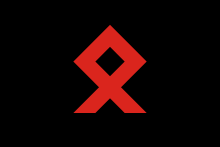
Key developments in international neo-Nazism during this time include the radicalisation of the Vlaamse Militanten Orde under former Hitler Youth member Bert Eriksson. They began hosting an annual conference; the "Iron Pilgrimage"; at Diksmuide, which drew kindred ideologues from across Europe and beyond. As well as this, the NSDAP/AO under Gary Lauck arose in the United States in 1972 and challenged the international influence of the Rockwellite WUNS. Lauck's organisation drew support from the National Socialist Movement of Denmark of Povl Riis-Knudsen and various German and Austrian figures who felt that the "National Democratic" parties were too bourgeois and insufficiently National Socialist in orientation. This included Michael Kühnen, Christian Worch, Bela Ewald Althans and Gottfried Küssel of the 1977-founded ANS/NS which called for the establishment of a Germanic Fourth Reich. Some ANS/NS members were imprisoned for planning paramilitary attacks on NATO bases in Germany and planning to liberate Rudolf Hess from Spandau Prison. The organisation was officially banned in 1983 by the Minister of the Interior.
During the late 1970s, a British subculture came to be associated with neo-Nazism; the skinheads. Portraying an ultra-masculine, crude and aggressive image, with working-class references, some of the skinheads joined the British Movement under Michael McLaughlin (successor of Colin Jordan), while others became associated with the National Front's Rock Against Communism project which was meant to counter the SWP's Rock Against Racism. The most significant music group involved in this project was Skrewdriver, led by Ian Stuart Donaldson. Together with ex-BM member Nicky Crane, Donaldson founded the international Blood & Honour network in 1987. By 1992 this network, with input from Harold Covington, had developed a paramilitary wing; Combat 18, which intersected with football hooligan firms such as the Chelsea Headhunters. The neo-Nazi skinhead movement spread to the United States, with groups such as the Hammerskins. It was popularised from 1986 onwards by Tom Metzger of the White Aryan Resistance. Since then it has spread across the world. Films such as Romper Stomper (1992) and American History X (1998) would fix a public perception that neo-Nazism and skinheads were synonymous.
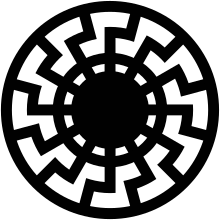
New developments also emerged on the esoteric level, as former Chilean diplomat Miguel Serrano built on the works of Carl Jung, Otto Rahn, Wilhelm Landig, Julius Evola and Savitri Devi to bind together and develop already existing theories. Serrano had been a member of the National Socialist Movement of Chile in the 1930s and from the early days of neo-Nazism he had been in contact with key figures across Europe and beyond. Despite this, he was able to work as an ambassador to numerous countries until the rise of Salvador Allende. In 1984 he published his book Adolf Hitler: The Ultimate Avatar. Serrano claimed that the Aryans were extragalactic beings who founded Hyperborea and lived the heroic life of Bodhisattvas, while the Jews were created by the Demiurge and were concerned only with coarse materialism. Serrano claimed that a new Golden Age can be attained if the Hyperboreans repurify their blood (supposedly the light of the Black Sun) and restore their "blood-memory." As with Savitri Devi before him, Serrano's works became a key point of reference in neo-Nazism.
Lifting of the Iron Curtain, 1990s–present
With the fall of the Berlin Wall and the collapse of the Soviet Union during the early 1990s, neo-Nazism began to spread its ideas in the East, as hostility to the triumphant liberal order was high and revanchism a widespread feeling. In Russia, during the chaos of the early 1990s, an amorphous mixture of KGB hardliners, Orthodox neo-Tsarist nostalgics (i.e., Pamyat) and explicit National Socialists found themselves strewn together in the same camp. They were united by opposition to the influence of the United States, against the liberalising legacy of Mikhail Gorbachev's perestroika and on the Jewish question, Soviet Zionology merged with a more explicit anti-Jewish sentiment. The most significant organisation representing this was Russian National Unity under the leadership of Alexander Barkashov, where black-uniform clad Russians marched with a red flag incorporating the Swastika under the banner of Russia for Russians. These forces came together in a last gasp effort to save the Supreme Soviet of Russia against Boris Yeltsin during the 1993 Russian constitutional crisis. As well as events in Russia, in newly independent ex-Soviet states, annual commemorations for SS volunteers now took place; particularly in Latvia, Estonia and the Ukraine.
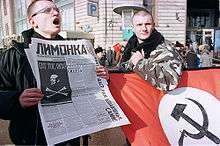
The Russian developments excited German neo-Nazism who dreamed of a Berlin—Moscow alliance against the supposedly "decadent" Atlanticist forces; a dream which had been thematic since the days of Remer. Zündel visited Russia and met with Russian National Unity luminaries such as ex-KGB general Aleksandr Stergilov. Despite these initial aspirations, international neo-Nazism and its close affiliates in ultra-nationalism would be split over the Bosnian War between 1992 and 1995, as part of the breakup of Yugoslavia. The split would largely be along ethnic and sectarian lines. The Germans and the French would largely back the Western Catholic Croats (Lauck's NSDAP/AO explicitly called for volunteers, which Kühnen's Free German Workers' Party answered and the French formed the "Groupe Jacques Doriot"), while the Russians and the Greeks would back the Orthodox Serbs (including Russians from Barkashov's Russian National Unity, Eduard Limonov's National Bolshevik Front and Golden Dawn members joined the Greek Volunteer Guard). Indeed, the revival of National Bolshevism was able to steal some of the thunder from overt Russian neo-Nazism, as ultra-nationalism was wedded with veneration of Joseph Stalin in place of Adolf Hitler, while still also flirting with Nazi aesthetics.
Analogous European movements
Outside Germany, in other countries which were involved with the Axis powers and had their own native ultra-nationalist movements, which sometimes collaborated with the Third Reich but were not technically German-style National Socialists, revivalist and nostalgic movements have emerged in the post-war period which, as neo-Nazism has done in Germany, seek to rehabilitate their various loosely associated ideologies. These movements include neo-fascists and post-fascists in Italy; Vichyites, Pétainists and "national Europeans" in France; Ustaše sympathisers in Croatia; neo-Chetniks in Serbia; Iron Guard revivalists in Romania; Hungarists and Horthyists in Hungary; Banderaists in the Ukraine (which had a complicated relationship with the Axis powers) and others.[16]
Italy

Following the last stand of Italian fascism with the German-supported Italian Social Republic towards the end of the Second World War, those elements within Italian society which remained loyal to the legacy of Benito Mussolini and fascism (especially veterans of the National Republican Army), rejecting both the Catholic and Communist alternatives prominent in mainstream Italian politics, founded the Italian Social Movement in 1946 under Giorgio Almirante. The MSI was regarded as the successor of the National Fascist Party and the Republican Fascist Party. The motto of the party was "not repudiate, not restore", indicating a more moderate parliamentary democratic neo-fascism, which did not heap scorn on the recent past. Italian society did not undergo a process as extensive as the post-war Denazification campaign in occupied Germany, partly due to the Cold War and the Western Allies not wanting Italy to move towards the Warsaw Pact (which was not an impossibility at the time).[17][18]
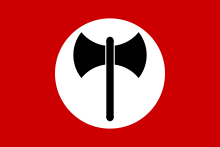
The Italian Social Movement held a similar position in Italian politics that the National Democratic Party of Germany did in Germany; careful enough to stay within the laws of the new democratic state, but still clearly identified with the Axis legacy. During the 1950s, the MSI moved closer to bourgeois conservative politics on the domestic front, which led to radical youths founding hardline splinter groups, such as Pino Rauti's Ordine Nuovo (later succeeded by Ordine Nero) and Stefano Delle Chiaie's Avanguardia Nazionale. These organisations were influenced by the esotericism of Julius Evola and considered the Waffen-SS and Romanian leader Corneliu Zelea Codreanu a reference, moving beyond Italian fascism. They were implicated in paramiliary attacks during the late 1960s to the early 1980s, such as the Piazza Fontana bombing. Delle Chiaie had even assisted Junio Valerio Borghese in a failed 1970 coup attempt known as the Golpe Borghese, which attempted to reinstate a fascist state in Italy.
During the late 1980s and early 1990s, the Italian Social Movement under the leadership of Gianfranco Fini moved closer to conservative politics, adopting a "post-fascist" position. This was opposed by the fascist element under Rauti who created Fiamma Tricolore in 1995. The party was dissolved under Fini in 1995, who replaced it with the National Alliance. This party rapidly moved away from any connection to the fascist past, towards the center-right in coalition with Silvio Berlusconi's Forza Italia. The two parties merged in 2009 to become The People of Freedom. Alessandra Mussolini, troubled by Fini's explicit condemnation of her grandfather broke with the AN to found Social Action. Aside from Fiamma Tricolore, the other extant neo-fascist groups in Italy are Forza Nuova, the Fronte Nazionale, Movimento Idea Sociale (another Rauti creation) and the cultural CasaPound project. In terms of current size, they are mostly negligible.
France
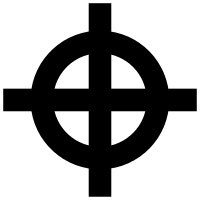
In France, the most enthusiastic collaborationists during the German occupation of France had been the National Popular Rally of Marcel Déat (former SFIO members) and the French Popular Party of Jacques Doriot (former French Communist Party members). These two groups, like the Germans, saw themselves as combining ultra-nationalism and socialism. In the south there existed the vassal state of Vichy France under the military "Hero of the Verdun", Marshal Philippe Pétain whose Révolution nationale emphasised an authoritarian Catholic conservative politics. Following the liberation of France and the creation of the Fourth French Republic, collaborationists were prosecuted during the épuration légale and nearly 800 put to death for treason under Charles de Gaulle.
In the aftermath of the Second World War, the main concern of the French radical right was the collapse of the French Empire, in particular the Algerian War, which led to the creation of the OAS. Outside of this, individual fascistic activists such as Maurice Bardèche (brother-in-law of Robert Brasillach), as well as SS-veterans Saint-Loup and René Binet, were active in France and involved in the European Social Movement and later the New European Order, alongside similar groups from across Europe. Early neo-fascist groups included Jeune Nation, which introduced the Celtic cross into use by radical right groups (an association which would spread internationally). A "neither East, nor West" pan-Europeanism was most popular among French fascistic activists until the late 1960s, partly motivated by feelings of national vulnerability following the collapse of their empire; thus the Belgian SS-veteran Jean-François Thiriart's group Jeune Europe also had a considerable French contingent.
It was the 1960s, during the Fifth French Republic, that a considerable upturn in French neo-fascism occurred; some of it in response to the Protests of 1968. The most explicitly pro-Nazi of these was the FANE of Mark Fredriksen. Neo-fascist groups included Pierre Sidos' Occident, the Ordre Nouveau (which was banned after violent clashes with the Trotskyist LCR) and the student-based Groupe Union Défense. A number of these activists such as François Duprat were instrumental in founding the Front National under Jean-Marie Le Pen; but the FN also included a broader selection from the French hard-right, including not only these neo-fascist elements, but also Catholic integrists, monarchists, Algerian War veterans, Poujadists and national-conservatives. Others from these neo-fascist micro-groups formed the Parti des forces nouvelles working against Le Pen.
Within the FN itself, Duprat founded the FANE-backed Groupes nationalistes révolutionnaires faction, until his 1978 assassination. The subsequent history of the French hard right has been the conflict between the national-conservative controlled FN and "national revolutionary" (fascistic and National Bolshevik) splinter or opposition groups. The latter include groups in the tradition of Thiriart and Duprat, such as the Parti communautaire national-européen, Troisième voie, the Nouvelle Résistance of Christian Bouchet,[19] Unité Radicale and most recently Bloc identitaire. Direct splits from the FN include the 1987 founded FANE-revival Parti nationaliste français et européen, which was disbanded in 2000. Neo-Nazi organizations are outlawed in the Fifth French Republic, yet a significant number of them still exist.[20]
Croatia

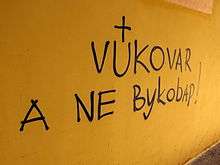
Neo-Nazis in Croatia base their ideology on the writings of Ante Pavelić and the Ustaše, a fascist anti-Yugoslav separatist movement.[21] The Ustaše regime committed a genocide against Serbs, Jews and Roma. At the end of World War II, many Ustaše members fled to the West, where they found sanctuary and continued their political and terrorist activities (which were tolerated due to Cold War hostilities).[22][23]
In 1999, Zagreb's Square of the Victims of Fascism was renamed Croatian Nobles Square, provoking widespread criticism of Croatia's attitude towards the Holocaust.[24] In 2000, the Zagreb City Council again renamed the square into Square of the Victims of Fascism.[25] Many streets in Croatia were renamed after the prominent Ustaše figure Mile Budak, which provoked outrage amongst the Serbian minority. Since 2002, there has been a reversal of this development, and streets with the name of Mile Budak or other persons connected with the Ustaše movement are few or non-existent.[26] A plaque in Slunj with the inscription "Croatian Knight Jure Francetić" was erected to commemorate Francetić, the notorious Ustaše leader of the Black Legion. The plaque remained there for four years, until it was removed by the authorities.[26][27]
In 2003, Croatian penal code was amended with provisions prohibiting the public display of Nazi symbols, the propagation of Nazi ideology, historical revisionism and holocaust denial but the amendments were annulled in 2004 since they were not enacted in accordance with a constitutionally prescribed procedure.[28] Nevertheless, since 2006 Croatian penal code explicitly prohibits any type of hate crime based on race, color, gender, sexual orientation, religion or national origin.[29]
There have been instances of hate speech in Croatia, such as the use of the phrase Srbe na vrbe! ("[Hang] Serbs on the willow trees!"). In 2004, an Orthodox church was spray-painted with pro-Ustaše graffiti.[30][31] During some protests in Croatia, supporters of Ante Gotovina and other at the time suspected war criminals (all acquitted in 2012) have carried nationalist symbols and pictures of Pavelić.[32] On 17 May 2007, a concert in Zagreb by Thompson, a popular Croatian singer, was attended by 60,000 people, some of them wearing Ustaše uniforms. Some gave Ustaše salutes and shouted the Ustaše slogan "Za dom spremni" ("For the homeland – ready!"). This event prompted the Simon Wiesenthal Center to publicly issue a protest to the Croatian president.[33][34][35][36][37] Cases of displaying Ustashe memorabilia have been recorded at the commemoration for the Bleiburg repatriations held annually in Bleiburg, Austria.[38]
Serbia
An example of neo-Nazism in Serbia is the group Nacionalni stroj. In 2006 charges were brought against 18 leading members.[39][40][41] The other organization was Obraz which was banned on 12 June 2012 by Constitutional Court of Serbia.[42] Besides political parties, there are a few militant neo-Nazi organizations in Serbia, such as Blood & Honour Serbia and Combat 18.[43]
Earlier, on 18 June 1990, Vojislav Šešelj organized the Serbian Chetnik Movement (SČP) though it wasn't permitted official registration due to its obvious Chetnik identification. On 23 February 1991, it merged with the National Radical Party (NRS), establishing the Serbian Radical Party (SRS) with Šešelj as president and Tomislav Nikolić as vice president.[44] It was a Chetnik party,[45] oriented towards neo-fascism with a striving for the territorial expansion of Serbia.[44][46]
Hungary
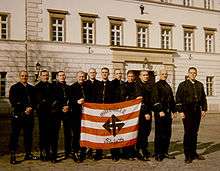
In Hungary, the historical political party which allied itself ideologically with German National Socialism and drew inspiration from it, was the Arrow Cross Party of Ferenc Szálasi. They referred to themselves explicitly as National Socialists and within Hungarian politics this tendency is known as Hungarism. After the Second World War, exiles such as Árpád Henney kept the Hungarist tradition alive. Following the fall of the Hungarian People's Republic in 1989, which was a Marxist-Leninist state and a member of the Warsaw Pact, many new parties emerged. Amongst these was the Hungarian National Front of István Győrkös, which was a Hungarist party and considered itself the heirs of Arrow Cross-style National Socialism (a self-description they explicitly embraced); it forged links with Gottfried Küssel and the NSDAP/AO. In the 2000s, Győrkös' movement moved closer to a national communist and neo-Eurasian position, aligned with Aleksandr Dugin, cooperating with the Hungarian Workers' Party. Some Hungarists opposed this and founded the Pax Hungarica Movement.
In modern Hungary, the ultranationalist Jobbik is regarded by some scholars as a neo-Nazi party; for example, it has been termed as such by Randolph L. Braham.[47] The party denies being neo-Nazi, although "there is extensive proof that the leading members of the party made no effort to hide their racism and anti-Semitism."[48] Rudolf Paksa, a scholar of the Hungarian far-right, describes Jobbik as "anti-Semitic, racist, homophobic and chauvinistic" but not as neo-Nazi because it does not pursue the establishment of a totalitarian regime.[48] Historian Krisztián Ungváry writes that "It is safe to say that certain messages of Jobbik can be called open neo-Nazi propaganda. However, it is quite certain that the popularity of the party is not due to these statements."[49]
Romania
In Romania, the ultra-nationalist movement which allied itself with the Axis powers and German National Socialism was the Iron Guard, also known as the Legion of the Archangel Michael. There are some modern political organisations which consider themselves heirs of Legionarism, this includes Noua Dreaptă and the "Everything For the Country" Party, founded by former Iron Guard members. The latter organisation was outlawed in 2015. Aside, from these Romanian organisations, the Sixty-Four Counties Youth Movement representing ultra-nationalism from the Hungarian minority is also present, especially in Transylvania.[50] Other nationalistic and irredentist groups such as the Greater Romania Party do not originate from Legionarism, but in fact grew out of national communist tendencies from the era of Nicolae Ceaușescu (the party was founded by his "court poet" Corneliu Vadim Tudor).[51]
Spain
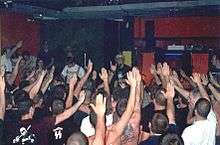
Spanish neo-Nazism is often connected to the country's Francoist and Falangist past, and nurtured by the ideology of the National Catholicism.[52][53]
According to a study by the newspaper ABC, black people are the ones who have suffered the most attacks by neo-Nazi groups, followed by Maghrebis and Latin Americans. They have also caused deaths in the anti-fascist group, such as the murder of the Madrid-born sixteen-year-old Carlos Palomino on 11 November 2007, stabbed with a knife by a soldier in the Legazpi metro station (Madrid).[54]
There have been other neo-Nazi cultural organizations such as the Spanish Circle of Friends of Europe (CEDADE) and the Circle of Indo-European Studies (CEI).[55]
The extreme right has little electoral support, with the presence of these groups of 0.36% (if the Plataforma per Catalunya (PxC) party is excluded with 66007 votes (0.39%), according to the voting data of the European elections of 2014. The first extreme right party FE de las JONS obtains 0.13% of the votes (21 577 votes), after doubling its results after the crisis; this is followed by the far-right party La España en Marcha (LEM) with 0.1% of the votes, National Democracy (DN) of the far-right with 0.08%, Republican Social Movement (MSR) (far-right) with 0.05% of the votes.[56]
Slovakia
The Slovak political party Kotlebists – People's Party Our Slovakia, which is represented in the National Council and European Parliament, is widely characterized as neo-Nazi.[57][58][59] Kotleba has softened its image over time and now disputes that is fascist or neo-Nazi, even suing a media outlet that described it as neo-Nazi. As of 2020, the party spokesperson was Ondrej Durica, a former member of the neo-Nazi band Biely Odpor (White Resistance). 2020 candidate Andrej Medvecky was convicted of attacking a black man while shouting racial slurs; another candidate, Anton Grňo, was fined for making a fascist salute. The party still celebrates 14 March, the anniversary of the founding of the fascist Slovak State.[60] In 2020, party leader Marian Kotleba was facing trial for writing checks for 1,488 euros, alleged to be a reference to Fourteen Words and Heil Hitler.[61]
Ukraine
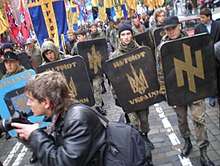

In 1991 Svoboda was founded as the Social-National Party of Ukraine.[62] The party combined radical nationalism and neo-Nazi features.[63][64][65] It was renamed and rebranded 13 years later as All-Ukrainian Association Svoboda in 2004 under Oleh Tyahnybok. In 2016, The Nation reported that "in Ukrainian municipal elections held [in October 2015], the neo-Nazi Svoboda party won 10 percent of the vote in Kiev and placed second in Lviv. The Svoboda party’s candidate actually won the mayoral election in the city of Konotop."[66] The Svoboda party mayor in Konotop reportedly has the number "14/88" displayed on his car and has refused to display the city's official flag because it contains a star of David, and has implied that Jews were responsible for the Holodomor.[63]
The topic of Ukrainian nationalism and its alleged relationship to neo-Nazism came to the fore in polemics about the more radical elements involved in the Euromaidan protests and subsequent Ukrainian crisis from 2013 onward.[65] Some Russian, Latin American, U.S. and Israeli media have attempted to portray the Ukrainian nationalists in the conflict as neo-Nazi.[67] The main Ukrainian organisations involved with a neo-Banderaite legacy are Right Sector,[68] Svoboda and Azov Battalion. The persons regarded as Ukraine's national heroes — Stepan Bandera, Roman Shukhevych or Dmytro Klyachkivsky of the Organization of Ukrainian Nationalists (OUN) and Ukrainian Insurgent Army (UPA) — at times supported and then opposed the presence of the Third Reich in Ukraine.[69][70]
After Yanokovych's ouster in February 2014, the interim Yatsenyuk Government placed 4 Svoboda members in leading positions: Oleksandr Sych as Vice Prime Minister of Ukraine, Ihor Tenyukh as Minister of Defense, lawyer Ihor Shvaika as Minister of Agrarian Policy and Food and Andriy Mokhnyk as Minister of Ecology and Natural Resources of Ukraine.[71][72] Since 14 April 2016 the Chairman of the Ukrainian Parliament has been Andriy Parubiy,[73][74] the co-founder of the neo-Nazi Social-National Party of Ukraine.[72]
In June 2015, Democratic Representative John Conyers and his Republican colleague Ted Yoho offered bipartisan amendments to block the U.S. military training of Ukraine's Azov Battalion — called a "neo-Nazi paramilitary militia" by Conyers and Yoho.[75][76][66] Andriy Biletsky, the head of the ultra-nationalist and neo-Nazi political groups Social-National Assembly and Patriots of Ukraine,[77] has been commander of the Azov Battalion.[78] Azov Battalion of the Ukrainian National Guard[75] is fighting pro-Russian separatists in the War in Donbass.[79][80] Some members of the battalion are openly white supremacists.[78]
The radical nationalists group С14, whose members openly expressed neo-Nazi views, gained notoriety in 2018 for being involved in violent attacks on Romany camps.[81][82][83]
Issues
Ex-Nazis in mainstream politics

The most significant case on an international level was the election of Kurt Waldheim to the Presidency of Austria in 1986. It came to light that Waldheim had been a member of the National Socialist German Students' League, the SA and served as an intelligence officer during the Second World War. Following this he served as an Austrian diplomat and was the Secretary-General of the United Nations from 1972 until 1981. After revelations of Waldheim's past were made by an Austrian journalist, Waldheim clashed with the World Jewish Congress on the international stage. Waldheim's record was defended by Bruno Kreisky, an Austrian Jew who served as Chancellor of Austria. The legacy of the affair lingers on, as Victor Ostrovsky has claimed the Mossad doctored the file of Waldheim to implicate him in war crimes.
Contemporary right-wing populism
Some critics have sought to draw a connection between Nazism and modern right-wing populism in Europe, but the two are not widely regarded as interchangeable by most academics. In Austria, the Freedom Party of Austria (FPÖ) served as a shelter for ex-Nazis almost from its inception.[84] In 1980, scandals undermined Austria's two main parties and the economy stagnated. Jörg Haider became leader of the FPÖ and offered partial justification for Nazism, calling its employment policy effective. In the 1994 Austrian election, the FPÖ won 22 percent of the vote, as well as 33 percent of the vote in Carinthia and 22 percent in Vienna; showing that it had become a force capable of reversing the old pattern of Austrian politics.[85]
Historian Walter Laqueur writes that even though Haider welcomed former Nazis at his meetings and went out of his way to address Schutzstaffel (SS) veterans, the FPÖ is not a fascist party in the traditional sense, since it has not made anti-communism an important issue, and it does not advocate the overthrow of the democratic order or the use of violence. In his view, the FPÖ is "not quite fascist", although it is part of a tradition, similar to that of 19th-century Viennese mayor Karl Lueger, which involves nationalism, xenophobic populism, and authoritarianism.[86] Haider, who in 2005 left the Freedom Party and formed the Alliance for Austria's Future, was killed in a traffic accident in October 2008.[87]
Barbara Rosenkranz, the Freedom Party's candidate in Austria's 2010 presidential election, was controversial for having made allegedly pro-Nazi statements.[88] Rosenkranz is married to Horst Rosenkranz, a key member of a banned neo-Nazi party, who is known for publishing far-right books. Rosenkranz says she cannot detect anything "dishonourable" in her husband's activities.[89]
Around the world
Europe
Belgium
A Belgian neo-Nazi organization, Bloed, Bodem, Eer en Trouw (Blood, Soil, Honour and Loyalty), was created in 2004 after splitting from the international network (Blood and Honour). The group rose to public prominence in September 2006, after 17 members (including 11 soldiers) were arrested under the December 2003 anti-terrorist laws and laws against racism, antisemitism and supporters of censorship. According to Justice Minister Laurette Onkelinx and Interior Minister Patrick Dewael, the suspects (11 of whom were members of the military) were preparing to launch terrorist attacks in order to "destabilize" Belgium.[90] According to the journalist Manuel Abramowicz, of the Resistances,[91] the extremists of the radical right have always had as its aim to "infiltrate the state mechanisms," including the army in the 1970s and the 1980s, through Westland New Post and the Front de la Jeunesse.[92]
A police operation, which mobilized 150 agents, searched five military barracks (in Leopoldsburg near the Dutch border, Kleine-Brogel, Peer, Brussels (Royal military school) and Zedelgem) as well as 18 private addresses in Flanders. They found weapons, munitions, explosives and a homemade bomb large enough to make "a car explode". The leading suspect, B.T., was organizing the trafficking of weapons and was developing international links, in particular with the Dutch far-right movement De Nationale Alliantie.[93]
Bosnia and Herzegovina
The neo-Nazi white nationalist organization Bosanski Pokret Nacionalnog Ponosa (Bosnian Movement of National Pride) was founded in Bosnia and Herzegovina in July 2009. Its model is the Waffen-SS Handschar Division, which was composed of Bosniak volunteers.[94] It proclaimed its main enemies to be "Jews, Roma, Serbian Chetniks, the Croatian separatists, Josip Broz Tito, Communists, homosexuals and blacks".[95] Its ideology is a mixture of Bosnian nationalism, National Socialism and white nationalism. It says "Ideologies that are not welcome in Bosnia are: Zionism, Islamism, communism, capitalism. The only ideology good for us is Bosnian nationalism because it secures national prosperity and social justice..."[96] The group is led by a person nicknamed Sauberzwig, after the commander of the 13th SS Handschar. The group's strongest area of operations is in the Tuzla area of Bosnia.
Czech Republic
The government of the Czech Republic strictly punishes neo-Nazism (Czech: Neonacismus). According to a report by the Ministry of the Interior of the Czech Republic, neo-Nazis committed more than 211 crimes in 2013. The Czech Republic has various neo-Nazi groups. One of them is the group Wotan Jugend, based in Germany.
Estonia
In 2006, Roman Ilin, a Jewish theatre director from St. Petersburg, Russia, was attacked by neo-Nazis when returning from a tunnel after a rehearsal. Ilin subsequently accused Estonian police of indifference after filing the incident.[97] When a dark-skinned French student was attacked in Tartu, the head of an association of foreign students claimed that the attack was characteristic of a wave of neo-Nazi violence. An Estonian police official, however, stated that there were only a few cases involving foreign students over the previous two years.[98] In November 2006, the Estonian government passed a law banning the display of Nazi symbols.[99]
The 2008 United Nations Human Rights Council Special Rapporteur's Report noted that community representatives and non-governmental organizations devoted to human rights had pointed out that neo-Nazi groups were active in Estonia—particularly in Tartu—and had perpetrated acts of violence against non-European minorities.[100]
Germany
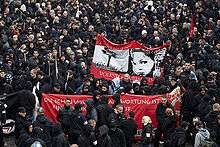
Following the failure of the National Democratic Party of Germany in the election of 1969, small groups committed to the revival of Nazi ideology began to emerge in Germany. The NPD splintered, giving rise to paramilitary Wehrsportgruppe. These groups attempted to organize under a national umbrella organization, the Action Front of National Socialists/National Activists.[101] Neo-Nazi movements in East Germany began as a rebellion against the Communist regime; the banning of Nazi symbols helped neo-Nazism to develop as an anti-authoritarian youth movement.[102] Mail order networks developed to send illegal Nazi-themed music cassettes and merchandise to Germany.[103]
Turks in Germany have been victims of neo-Nazi violence on several occasions. In 1992, two young girls were killed in the Mölln arson attack along with their grandmother; nine others were injured.[104][105] In 1993, five Turks were killed in the Solingen arson attack.[106] In response to the fire Turkish youth in Solingen rioted chanting "Nazis out!" and "We want Nazi blood". In other parts of Germany police had to intervene to protect skinheads from assault.[107] The Hoyerswerda riots and Rostock-Lichtenhagen riots targeting migrants and ethnic minorities living in Germany also took place during the 1990s.[101]
Between 2000 and 2007, eight Turkish immigrants, one Greek and a German policewoman were murdered by the neo-Nazi National Socialist Underground.[108] The NSU has its roots in the former East German area of Thuringia, which The Guardian identified as "one of the heartlands of Germany’s radical right". The German intelligence services have been criticized for extravagant distributions of cash to informants within the far-right movement. Tino Brandt publicly boasted on television that he had received around €100,000 in funding from the German state. Though Brandt did not give the state "useful information", the funding supported recruitment efforts in Thuringia during the early 1990s. (Brandt was eventually sentenced to five and a half years in prison on for 66 counts of child prostitution and child sexual abuse).[109]
Police were only able to locate the killers when they were tipped off following a botched bank robbery in Eisenach. As the police closed in on them, the two men committed suicide. They had evaded capture for 13 years. Beate Zschäpe, who had been living with the two men in Zwickau, turned herself in to the German authorities a few days later. Zschäpe's trial began in May 2013; she was charged with nine counts of murder. She plead "not guilty". According to The Guardian, the NSU may have enjoyed protection and support from certain "elements of the state". Anders Behring Breivik, a fan of Zschäpe's, reportedly sent her a letter from prison in 2012.[109]
According to the annual report of Germany's interior intelligence service (Verfassungsschutz) for 2012, at the time there were 26,000 right-wing extremists living in Germany, including 6,000 neo-Nazis.[110] In January 2020, Combat 18 was banned in Germany, and raids directed against the organization were made across the country.[111] In March 2020, United German Peoples and Tribes, which is part of Reichsbürger, a neo-Nazi movement that rejects the German state as a legal entity, was raided by the German police.[112] Holocaust denial is a crime, according to the German Criminal Code (Strafgesetzbuch § 86a) and § 130 (public incitement).
Greece
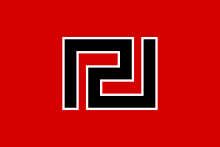
In April 1967, a few weeks prior to an election, a military coup d'état took place in Greece and a fascist military government ruled the country from 1967 to 1974. It was called the "Regime of the Colonels", and was headed by Colonel Georgios Papadopoulos. The official reason given for the coup was that a "communist conspiracy" had infiltrated all levels of society.[113] Although there have been persistent rumors about an active support of the coup by the U.S. government, there is no evidence to support such claims.[114][115] The timing of the coup apparently caught the CIA by surprise.[116]
The far-right political party Golden Dawn (Χρυσή Αυγή - Chrysi Avyi) is generally labelled neo-Nazi, although the group rejects this label.[117] A few Golden Dawn members participated in the Bosnian War in the Greek Volunteer Guard (GVG) and were present in Srebrenica during the Srebrenica massacre.[118][119] The party has its roots in Papadopoulos' regime.
There is often collaboration between the state and neo-Nazi elements in Greece.[120] In 2018, during the trial of sixty-nine members of the Golden Dawn party, evidence was presented of the close ties between the party and the Hellenic Police.[121]
Golden Dawn has spoken out in favour of the Assad regime in Syria,[122] and the Strasserist group Black Lily have claimed to have sent mercenaries to Syria to fight alongside the Syrian regime, specifically mentioning their participation in the Battle of al-Qusayr.[123] In the 6 May 2012 legislative election, Golden Dawn received 6.97% of the votes, entering the Greek parliament for the first time with 21 representatives, but when the elected parties were unable to form a coalition government a second election was held in June 2012. Golden Dawn received 6.92% of the votes in the June election and entered the Greek parliament with 18 representatives.
Since 2008, neo-Nazi violence in Greece has targeted immigrants, leftists and anarchist activists. In 2009, certain far-right groups announced that Agios Panteleimonas in Athens was off limits to immigrants. Neo-Nazi patrols affiliated with the Golden Dawn party began attacking migrants in this neighborhood. The violence continued escalating through 2010.[120] In 2013, after the murder of anti-fascist rapper Pavlos Fyssas, the number of hate crimes in Greece declined for several years until 2017. Many of the crimes in 2017 have been attributed to other groups like the Crypteia Organisation and Combat 18 Hellas.[121]
Netherlands
The Coordination Forum for Countering Antisemitism reports that anti-semitic graffiti was found at a Jewish school in Leek, Groningen on 17 May 2011. The graffiti consisted of a swastika and the text "C18", or Combat 18, a neo-Nazi organisation active throughout Europe. The number 18 refers to the initials of Adolf Hitler, A and H being the first and eighth letters of the alphabet, respectively.[124]
Poland
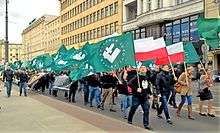
Under the Polish Constitution promoting any totalitarian system such as Nazism and fascism (as well as communism) as well as inciting violence and/or racial hatred is illegal.[125] This was further re-enforced in the Polish Penal Code where discrediting any group or persons on national, religious, or racial grounds carries a sentence of 3 years.[126]
Although several small far-right and anti-semitic organisations exist, most notably NOP and ONR (both of which exist legally), they frequently adhere to Polish nationalism and National Democracy, in which Nazism is generally considered to be against ultra-nationalist principles, and although they are classed as nationalist and fascist movements, they are at the same time considered anti-Nazi. Some of their elements may resemble neo-Nazi features, but these groups frequently dissociate themselves from Nazi elements, claiming that such acts are unpatriotic and they argue that Nazism misappropriated or slightly altered several pre-existing symbols and features, such as distinguishing the Roman salute from the Nazi salute.[127]
Self-declared neo-Nazi movements in Poland frequently treat Polish culture and traditions with contempt, are anti-Christian and translate various texts from German, meaning they are considered movements favouring Germanisation.[128]
According to several reporter investigations the Polish government turns a blind eye to these groups and they are free to spread their ideology, frequently dismissing their existence as conspiracy theories, dismissing acts political provocations, deeming them too insignificant to pose a threat, or attempting to justify or diminish the seriousness of their actions.[129][130][131][132]
Russia
There are a few Russian neo-Nazis that openly admire Adolf Hitler and use the swastika as their symbol. Russian neo-Nazis are characterized by racism, antisemitism, homophobia, Islamophobia and extreme xenophobia towards people from Asia.[133] Their ideology centers on defending Russian national identity against what they perceive as a takeover by minority groups such as Jews, Caucasians, gay people, Central Asians, East Asians, Roma people (gypsies), and Muslims.
.jpg)
Russian neo-Nazis have made it an explicit goal to take over the country by force, and have put serious effort into preparing for this. Paramilitary organizations operating under the guise of sports clubs have trained their members in squad tactics, hand to hand combat and weapons handling. They have stockpiled and used weapons, often illegally.
Some observers have noted a subjective irony of Russians embracing Nazism, because one of Hitler's ambitions at the start of World War II was the Generalplan Ost (Master Plan East) which envisaged to exterminate, expel, or enslave most or all Slavs from central and eastern Europe (e.g., Russians, Ukrainians, Poles etc.).[134] Russian neo-Nazis deny the authenticity of this plan and instead emphasize the 1939-1941 Nazi-Soviet non-aggression pact.[134] At the end of the Nazi invasion of the Soviet Union, over 25 million Soviet citizens had died.[135]
The dissolution of the Soviet Union in 1991 caused great economic and social problems, including widespread unemployment and poverty. Several far-right paramilitary organizations were able to tap into popular discontent, particularly among marginalized, lesser educated and unemployed youths. Of the three major age groups — youths, adults, and the elderly — youths may have been hit the hardest. The elderly suffered due to inadequate (or unpaid) pensions, but they found effective political representation in the Communist Party, and generally had their concerns addressed through better budget allocations. Adults, although often suffering financially and psychologically due to job losses, were generally able to find new sources of income.
Russian National Unity (RNE), founded in 1990 and led by Alexander Barkashov, has claimed to have members in 250 cities. RNE adopted the swastika as its symbol, and sees itself as the avant-garde of a coming national revolution. It is critical of other major far-right organizations, such as the Liberal Democratic Party of Russia (LDPR). Historian Walter Laqueur calls RNE far closer to the Nazi model than the LDPR. RNE publishes several news sheets; one of them, Russky poryadok, claims to have a circulation of 150,000. Full members of RNE are called Soratnik (comrades in arms), receive combat training at locations near Moscow, and many of them work as security officers or armed guards.[136]
On 15 August 2007, Russian authorities arrested a student for allegedly posting a video on the Internet which appears to show two migrant workers being beheaded in front of a red and black swastika flag.[137] Alexander Verkhovsky, the head of a Moscow-based center that monitors hate crime in Russia, said, "It looks like this is the real thing. The killing is genuine ... There are similar videos from the Chechen war. But this is the first time the killing appears to have been done intentionally."[138]
Sweden
Neo-Nazi activities in Sweden have previously been limited to white supremacist groups, few of which have a membership over a few hundred members.[139] The main neo-Nazi organization as of 2017 is the Nordic Resistance Movement. The Nordic Resistance Movement self-identifies as a National Socialist political movement with a paramilitary branch. They are also active in Norway, Finland, and Denmark.
Switzerland
The neo-Nazi and white power skinhead scene in Switzerland has seen significant growth in the 1990s and 2000s.[140] It is reflected in the foundation of the Partei National Orientierter Schweizer in 2000, which resulted in an improved organizational structure of the neo-Nazi and white supremacist scene.
United Kingdom
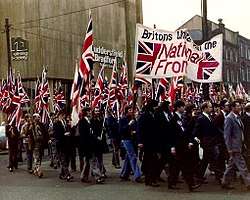
In 1962 the British neo-Nazi activist Colin Jordan formed the National Socialist Movement (NSM) which later became the British Movement (BM) in 1968.[141][142]
John Tyndall, a long-term neo-Nazi activist in the UK, led a break-away from the National Front to form an openly neo-Nazi party named the British National Party.[143] In the 1990s, the party formed a group for protecting its meetings named Combat 18,[144] which later grew too violent for the party to control and began to attack members of the BNP who were not perceived as supportive of neo-Nazism.[145] Under the subsequent leadership of Nick Griffin, the BNP distanced itself from neo-Nazism, although many members (including Griffin himself) have been accused of links to other neo-Nazi groups.[146]
The UK has also been a source of neo-Nazi music, such as the band Skrewdriver.[147]
Asia
India
Though Hindu nationalists distanced themselves from the totalitarian regimes with whom they had previously enjoyed close ties, Nazism and Nazi occultism, in particular, have remained a subject of interest in India throughout the post-War era.[148]
Pakistan
Pro-Nazi sentiment is widespread in Pakistan, according to the German magazine Der Spiegel, compounded by the anti-Semitism engendered by the opposition to Israel and support for Palestine general throughout the region. Such attitudes, exemplified by a belief that Hitler was a military genius, are shared by both Muslims and Hindus, and are related to the belief that Pakistanis are Aryans, and therefore would be accepted in Nazi Germany.[149]
Israel
Neo-Nazi activity is not common or widespread in Israel, and the few reported activities have all been the work of extremists, who were punished severely. One notable case is that of Patrol 36, a cell in Petah Tikva made up of eight teenage immigrants from the former Soviet Union who had been attacking foreign workers and gay people, and vandalizing synagogues with Nazi images.[150][151] These neo-Nazis were reported to have operated in cities across Israel, and have been described as being influenced by the rise of neo-Nazism in Europe;[150][151][152] mostly influenced by similar movements in Russia and Ukraine, as the rise of the phenomenon is widely credited to immigrants from those two states, the largest sources of emigration to Israel.[153] Widely publicized arrests have led to a call to reform the Law of Return to permit the revocation of Israeli citizenship for – and the subsequent deportation of – neo-Nazis.[151]
Mongolia
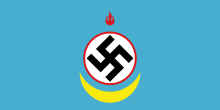
From 2008, Mongolian neo-Nazi groups have defaced buildings in Ulaanbaatar, smashed Chinese shopkeepers' windows, and killed Chinese immigrants. The neo-Nazi Mongols' targets for violence are Chinese, Koreans,[154] Mongol women who have sex with Chinese men, and LGBT people.[155] They wear Nazi uniforms and revere the Mongol Empire and Genghis Khan. Though Tsagaan Khass leaders say they do not support violence, they are self-proclaimed Nazis. "Adolf Hitler was someone we respect. He taught us how to preserve national identity," said the 41-year-old co-founder, who calls himself Big Brother. "We don't agree with his extremism and starting the Second World War. We are against all those killings, but we support his ideology. We support nationalism rather than fascism." Some have ascribed it to poor historical education.[154]
Taiwan
The National Socialism Association (NSA) is a neo-Nazi political organisation founded in Taiwan in September 2006 by Hsu Na-chi (Chinese: 許娜琦), at that time a 22-year-old female political science graduate of Soochow University. The NSA has an explicit stated goal of obtaining the power to govern the state. The Simon Wiesenthal Centre condemned the National Socialism Association on 13 March 2007 for championing the former Nazi dictator and blaming democracy for social unrest in Taiwan.[156]
Turkey
A neo-Nazi group existed in 1969 in İzmir, when a group of former Republican Villagers Nation Party members (precursor party of the Nationalist Movement Party) founded the association "Nasyonal Aktivitede Zinde İnkişaf" (Vigorous Development in National Activity). The club maintained two combat units. The members wore SA uniforms and used the Hitler salute. One of the leaders (Gündüz Kapancıoğlu) was re-admitted to the Nationalist Movement Party in 1975.[157]
Apart from neo-fascist[158][159][160][161][162][163][164] Grey Wolves and the Turkish ultranationalist[165][166][167][168][169][170] Nationalist Movement Party, there are some neo-Nazi organizations in Turkey such as the Turkish Nazi Party[171] or the National Socialist Party of Turkey, which are mainly based on the Internet.[172][173][174]
Iran

Several neo-Nazi groups were active in Iran, although they are now defunct. Advocates of Nazism continue to exist in Iran and are mainly based on the Internet.[175][176]
Americas
Brazil
Several Brazilian neo-Nazi gangs appeared in the 1990s in Southern and Southeastern Brazil, regions with mostly white people, with their acts gaining more media coverage and public notoriety in the 2010s.[177][178][179][180][181][182][183] Some members of Brazilian neo-Nazi groups have been associated with football hooliganism.[184] Their targets have included African, South American and Asian immigrants; Jews, Muslims, Catholics and atheists; Afro-Brazilians and internal migrants with origins in the northern regions of Brazil (who are mostly brown-skinned or Afro-Brazilian);[182][185] homeless people, prostitutes; recreational drug users; feminists and—more frequently reported in the media—gay people, bisexuals, and transgender and third-gender people.[181][186][187] News of their attacks has played a role in debates about anti-discrimination laws in Brazil (including to some extent hate speech laws) and the issues of sexual orientation and gender identity.[188][189][190]
Canada
Neo-Nazism in Canada began with the formation of the Canadian Nazi Party in 1965. In the 1970s and 1980s, neo-Nazism continued to spread in the country as organizations including the Western Guard Party and Church of the Creator (later renamed Creativity) promoted white supremacist ideals.[191] Founded in the United States in 1973, Creativity calls for white people to wage racial holy war (Rahowa) against Jews and other perceived enemies.[192]
Don Andrews founded the Nationalist Party of Canada in 1977. The purported goals of the unregistered party are "the promotion and maintenance of European Heritage and Culture in Canada," but the party is known for anti-Semitism and racism. Many influential neo-Nazi Leaders, such as Wolfgang Droege, were affiliated with the party, but many of its members left to join the Heritage Front, which was founded in 1989.[193]
Droege founded the Heritage Front in Toronto at a time when leaders of the white supremacist movement were "disgruntled about the state of the radical right" and wanted to unite unorganized groups of white supremacists into an influential and efficient group with common objectives.[193] Plans for the organization began in September 1989, and the formation of the Heritage Front was formally announced a couple of months later in November. In the 1990s, George Burdi of Resistance Records and the band Rahowa popularized the Creativity movement and the white power music scene.[194]
Controversy and dissention has left many Canadian neo-Nazi organizations dissolved or weakened.[193]
Chile
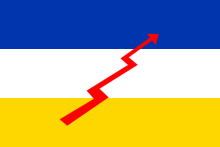
After the dissolution of the National Socialist Movement of Chile (MNSCH) in 1938, notable former members of MNSCH migrated into Partido Agrario Laborista (PAL), obtaining high positions.[195] Not all former MNSCH members joined the PAL; some continued to form parties that followed the MNSCH model until 1952.[195] A new old-school Nazi party was formed in 1964 by school teacher Franz Pfeiffer.[195] Among the activities of this group were the organization of a Miss Nazi beauty contest and the formation of a Chilean branch of the Ku Klux Klan.[195] The party disbanded in 1970. Pfeiffer attempted to restart it in 1983 in the wake of a wave of protests against the Augusto Pinochet regime.[195]
Nicolás Palacios considered the "Chilean race" to be a mix of two bellicose master races: the Visigoths of Spain and the Mapuche (Araucanians) of Chile.[196] Palacios traces the origins of the Spanish component of the "Chilean race" to the coast of the Baltic Sea, specifically to Götaland in Sweden,[196] one of the supposed homelands of the Goths. Palacios claimed that both the blonde-haired and the bronze-coloured Chilean Mestizo share a "moral physonomy" and a masculine psychology.[197] He opposed immigration from Southern Europe, and argued that Mestizos who are derived from south Europeans lack "cerebral control" and are a social burden.[198]
Costa Rica
Several neo-Nazi groups exist in Costa Rica. The first to receive attention was the Costa Rican National Socialist Party, which is now disbanded.[199] Others include Costa Rican National Socialist Youth, Costa Rican National Socialist Alliance, New Social Order, Costa Rican National Socialist Resistance (which is Costa Rica's member of the World Union of National Socialists)[200] and the Hiperborean Spear Society. The groups normally target Jewish-Costa Ricans, Afro-Costa Ricans, Communists, gay people and especially Nicaraguan and Colombian immigrants. The media has discovered the existence of an underground neo-Nazi group inside the police.[201]
After a series of fake news spread by several far-right Facebook[202] pages inciting hatred against Nicaraguan migrants, an anti-migration manifestation was organized on 18 August 2018 known as the "Taken of La Merced" after Nicaraguan refugees were falsely accused of having "taking" La Merced Park in San Jose, a common gathering of the Nicaraguan community.[202] Although some of the protesters were peaceful, participation of openly neo-Nazi groups and violent hooligans with criminal records caused riots and attacks on Nicaraguans or people suspected of being. The national police Public Force intervened[203] with up to 44 people arrested, 36 of such were Costa Rican and the rest Nicaraguans. Several violent article including Molotov bombs[202] were confiscated and some of the protesters identify themselves with Swastikas[202][203] and yelled "¡Fuera nicas!" (Nicas out!).[204]
United States
There are several neo-Nazi groups in the United States. The National Socialist Movement (NSM), with about 400 members in 32 states,[205] is currently the largest neo-Nazi organization in the United States.[206] After World War II, new organizations formed with varying degrees of support for Nazi principles. The National States' Rights Party, founded in 1958 by Edward Reed Fields and J. B. Stoner countered racial integration in the Southern United States with Nazi-inspired publications and iconography. The American Nazi Party, founded by George Lincoln Rockwell in 1959, achieved high-profile coverage in the press through its public demonstrations.[207]
The ideology of James H. Madole, leader of the National Renaissance Party, was influenced by Blavatskian Theosophy. Helena Blavatsky developed a racial theory of evolution, holding that the white race was the "fifth rootrace" called the Aryan Race. According to Blavatsky, Aryans had been preceded by Atlanteans who had perished in the flood that sunk the continent Atlantis. The three races that preceded the Atlanteans, in Blavatsky's view, were proto-humans; these were the Lemurians, Hyperboreans and the first Astral rootrace. It was on this foundation that Madole based his claims that the Aryan Race has been worshiped as "White Gods" since time immemorial and proposed a governance structure based on the Hindu Laws of Manu and its hierarchical caste system.[208]
The First Amendment to the United States Constitution guarantees freedom of speech, which allows political organizations great latitude in expressing Nazi, racist, and anti-Semitic views. A First Amendment landmark case was National Socialist Party of America v. Village of Skokie, in which neo-Nazis threatened to march in a predominantly Jewish suburb of Chicago. The march never took place in Skokie, but the court ruling allowed the neo-Nazis to stage a series of demonstrations in Chicago.
In May 2018, graduating students at Baraboo High School, in Baraboo, Wisconsin, appeared to perform a Nazi salute in a photograph taken before their junior prom. The image went viral on social media six months later, in November 2018. The school decided not to punish the students due to their First Amendment rights.
The Institute for Historical Review, formed in 1978, is a Holocaust denial body associated with neo-Nazism.[209]
Organizations which report upon American neo-Nazi activities include the Anti-Defamation League and the Southern Poverty Law Center. American neo-Nazis are known to attack and harass minorities.[210]
In 2020 the FBI reclassified neo-Nazis to the same threat level as ISIS, Chris Wray, the Director of the Federal Bureau of Investigation stating “Not only is the terror threat diverse, it’s unrelenting".[211][212]
Uruguay
In 1998, a group of people belonging to the "Joseph Goebbels Movement" tried to burn down a synagogue, which also served as a Hebrew school, in the Pocitos neighborhood of Montevideo in Uruguay; an antisemitic pamphlet signed by the group was found in the building after the quick action of firefighters saved it. Another group, the racist and antisemitic neo-Nazi Euroamerikaners group, founded in 1996, said when they were interviewed by the newspaper La República de Montevideo that they had no involvement with the attack on the synagogue, but revealed that they maintain contacts with a group called Poder Blanco ("White Power"), also Uruguayan, as well as with neo-Nazi groups from Argentina and several European countries. Through the Internet they have received the solidarity of the Patria pro-fascist group, based in Spain. They also said that in the city of Canelones, Uruguay, fifty kilometers from Montevideo, there is a clandestine "Aryan church" which uses rituals taken from the Ku Klux Klan. The euroamerikaners declared that they did not tolerate interracial or gay couples. One of the militants said in the interview that "[...] if we see a black man with a white woman, we break them up ...". Other neo-Nazi incidents in Uruguay in 1998 included the bombing of a Jewish-owned small business in February, which injured two people, and the appearance of posters celebrating the anniversary of Hitler's birthday in April.[213]
Africa
Several groups in South Africa, such as Afrikaner Weerstandsbeweging and Blanke Bevrydingsbeweging, have often been described as neo-Nazi.[214] Eugène Terre'Blanche was a prominent South African neo-Nazi leader who was murdered in 2010.[215]
AfriForum is a South African Afrikaans political movement group with underlying views which support Apartheid and "self-determination" for whites.[216][217][218][219]
Oceania
There were a number of now-defunct Australian neo-Nazi groups, such as the Australian National Socialist Party (ANSP), which was formed in 1962 and merged into the National Socialist Party of Australia (1968-1970s), originally a splinter group, in 1968,[220] and Jack van Tongeren's Australian Nationalist Movement.[220]
White supremacist organisations active in Australia as of 2016 included local chapters of the Aryan Nations.[221] Blair Cottrell, former leader of the United Patriots Front, has tried to distance himself from neo-Nazism, but has nevertheless been accused of expressing "pro-Nazi views".[222] Australian Security Intelligence Organisation director Mike Burgess stated in February 2020 that neo-Nazis pose a "real threat" to Australia's security. Burgess maintained that there is a growing threat from the extreme right, and that its supporters "regularly meet to salute Nazi flags, inspect weapons, train in combat and share their hateful ideology".[223]
In New Zealand, historical neo-Nazi organisations include Unit 88 and the National Socialist Party of New Zealand.[224] White Nationalist organisations such as the New Zealand National Front have faced accusations of neo-Nazism.[225]
See also
References
Informational notes
- Some of the fascistic old-guard from the pre-war ultra-nationalist movements were more skeptical of the benefits of the Rockwell-Jordan uniform scene. Oswald Mosley of the Union Movement described Jordan as, "a midget trying to walk in the boots of giants." Meanwhile, Yockeyism leaned more to the left than the "official" fascistic Pan-Europeanism of those which would become the European Social Movement. The latter associated with Mosley, Maurice Bardèche and others upheld a strictly "neither East, nor West", third position in regards to Soviet and American power.
- While the intelligence claims in regards to the Rockwell's American costume group proved unfounded, a number of actual German National Socialists did relocate to the Middle East, some conveted to Islam and changed their names; particularly Egypt and Syria. This includes Johann von Leers, Alois Brunner, Aribert Heim, Franz Stangl, Gerhard Mertins, Hans Eisele, Walter Rauff, Artur Schmitt and others. The father of Neo-Nazism, Otto Ernst Remer, also fled to Egypt, then Syria during the 1950s.
Citations
- Gay, Kathlyn (1997) Neo-Nazis: A Growing Threat. Enslow. p.114. ISBN 9780894909016. Quote: "Neo-Nazis ... use fear and violence in their efforts to destroy minorities. Their goal is to establish a "superior" society."(emphasis added)
- Staff (ndg) "Ideologies: Neo Nazi" Southern Poverty Law Center. Quote: "While some neo-Nazi groups emphasize simple hatred, others are more focused on the revolutionary creation of a fascist political state." (emphasis added)
-
- Werner Bergmann; Rainer Erb (1997). Anti-Semitism in Germany: The Post-Nazi Epoch Since 1945. Transaction Publishers. p. 91. ISBN 978-1-56000-270-3. OCLC 35318351.
In contrast to today, in which rigid authoritarianism and neo-Nazism are characteristic of marginal groups, open or latent leanings toward Nazi ideology in the 1940s and 1950s
- Martin Polley (2000). A-Z of Modern Europe Since 1789. Routledge. pp. 103. ISBN 978-0-415-18597-4. OCLC 49569961.
Neo-Nazism, drawing heavily both on the ideology and aesthetics of the NSDAP, emerged in many parts of Europe and elsewhere in the economic crises of the 1970s, and has continued to influence a number of small political groups.
- "Neo-Nazism". ApologeticsIndex. 16 December 2005.
The term Neo-Nazism refers to any social, political and/or (quasi) religious movement seeking to revive Nazism. Neo-Nazi groups are racist hate groups that pattern themselves after Hitler’s philosophies. Examples include: Aryan Nations, National Alliance
- Werner Bergmann; Rainer Erb (1997). Anti-Semitism in Germany: The Post-Nazi Epoch Since 1945. Transaction Publishers. p. 91. ISBN 978-1-56000-270-3. OCLC 35318351.
-
- Lee McGowan (2002). The Radical Right in Germany: 1870 to the Present. Pearson Education. pp. 9, 178. ISBN 978-0-582-29193-5. OCLC 49785551.
- Brigitte Bailer-Galanda; Wolfgang Neugebauer. "Right-Wing Extremism in Austria: History, Organisations, Ideology". Archived from the original on 17 January 2012.
Right-wing extremism can be equated neither with Nazism nor with neo-Fascism or neo-Nazism. Neo-Nazism, a legal term, is understood as the attempt to propagate, in direct defiance of the law (Verbotsgesetz), Nazi ideology or measures such as the denial, playing-down, approval or justification of Nazi mass murder, especially the Holocaust.
- Martin Frost. "Neo Nazism". Archived from the original on 27 October 2007.
The term neo-Nazism refers to any social or political movement seeking to revive National Socialism, and which postdates the Second World War. Often, especially internationally, those who are part of such movements do not use the term to describe themselves.
- Lee, Martin A. 1997. The Beast Reawakens. Boston: Little, Brown and Co, pp. 85–118, 214–234, 277–281, 287–330, 333–378. On Volk concept, and a discussion of ethnonationalist integralism, see pp. 215–218
-
- Peter Vogelsang; Brian B. M. Larsen (2002). "Neo-Nazism". The Danish Center for Holocaust and Genocide Studies. Archived from the original on 9 November 2007. Retrieved 8 December 2007.
Neo-Nazism is the name for a modern offshoot of Nazism. It is a radically right-wing ideology, whose main characteristics are extreme nationalism and violent xenophobia. Neo-Nazism is, as the word suggests, a modern version of Nazism. In general, it is an incoherent right-extremist ideology, which is characterised by 'borrowing' many of the elements that constituted traditional Nazism.
- Ondřej Cakl; Klára Kalibová (2002). "Neo-Nazism". Faculty of Humanities at Charles University in Prague, Department of Civil Society Studies. Retrieved 8 December 2007.
Neo-Nazism: An ideology which draws upon the legacy of the Nazi Third Reich, the main pillars of which are an admiration for Adolf Hitler, aggressive nationalism ("nothing but the nation"), and hatred of Jews, foreigners, ethnic minorities, homosexuals and everyone who is different in some way.
- Peter Vogelsang; Brian B. M. Larsen (2002). "Neo-Nazism". The Danish Center for Holocaust and Genocide Studies. Archived from the original on 9 November 2007. Retrieved 8 December 2007.
- What is right-wing extremism? Bundesamt für Verfassungsschutz, n.d., retrieved 4 December 2017 (in English)
- "New Book, Black Sun, Looks at Fringes of National Socialism". Southern Poverty Law Center. 8 February 2015.
- "Neo-Nazis cloak themselves in eco-rhetoric". DW. 8 February 2015.
- "Darker Shades of Green". Red Pepper. 8 February 2015.
- "Fascist Ecology: The "Green Wing" of the Nazi Party and its Historical Antecedents". Peter Staudenmaier. 8 February 2015.
- Zubok, V. M. (Vladislav Martinovich) (2007). A failed empire : the Soviet Union in the Cold War from Stalin to Gorbachev. Chapel Hill: University of North Carolina Press. pp. 89–90. ISBN 978-0-8078-3098-7. OCLC 86090559.
- Evans, Richard J. (2008). The Third Reich at War. The Third Reich Trilogy. Penguin Books. pp. 747–748. ISBN 978-0-14-311671-4.CS1 maint: ref=harv (link)
- "About Simon Wiesenthal". Simon Wiesenthal Center. 2013. Section 11. Retrieved 17 November 2013.
- Hartmann, Ralph (2010). "Der Alibiprozeß". Den Aufsatz kommentieren (in German). Ossietzky 9/2010. Archived from the original on 2 December 2013. Retrieved 19 November 2013.
- Rückerl, Adalbert (1972). NS-Prozesse. Karlsruhe, Germany: Verlag C F Muller. p. 132. ISBN 9783788020156. Retrieved 8 September 2013.
Adalbert Rückerl, head of the Central Bureau for the Prosecution of National Socialist Crimes observed that because of the 1968 Dreher's amendment (§ 50 StGB), 90% of all Nazi war criminals in Germany enjoyed total immunity from prosecution.
CS1 maint: ref=harv (link) - Lõwy, Michael (1998) Fatherland Or Mother Earth?: Essays on the National Question Pluto Press. pp.65-66 ISBN 9780745313436
- Alessandra Kersevan2008: (Editor) Foibe - Revisionismo di stato e amnesie della repubblica. Kappa Vu. Udine.
- Pedaliu, Effie G. H. (2004). "Britain and the 'Hand-over' of Italian War Criminals to Yugoslavia, 1945-48". Journal of Contemporary History. 39 (4, Collective Memory): 503–29. doi:10.1177/0022009404046752. ISSN 0022-0094. JSTOR 4141408.
- Stratégies et pratiques du mouvement nationaliste-révolutionnaire français : départs, desseins et destin d'Unité Radicale (1989–2002) Archived 29 September 2007 at the Wayback Machine, Le Banquet, n°19, 2004 (in French)
- Henley, Jon (3 February 2005). "France says it will outlaw all neo-Nazi groups". The Guardian. London. Retrieved 3 November 2009.
-
- Yeomans, Rory, "Of "Yugoslav Barbarians" and Croatian Gentlemen Scholars: Nationalist Ideology and Racial Anthropology in Interwar Yugoslavia", in Turda, Marius and Paul Weindling, eds., "Blood And Homeland": Eugenics And Racial Nationalism in Central And Southeast Europe, 1900–1940 Central European University Press, 2006)
- Ognyanova, Irina. "Nationalism and National Policy in Independent State of Croatia (1941–1945)" (PDF). Usna.edu.
- Jonassohn, Kurt and Karin Solveig Björnson, Genocide and Gross Human Rights Violations (Transaction Publishers 1998), p. 279
- "Headquarters Counter Intelligence Corps Allied Forces Headquarters APO 512, 30 January 1947: Present Whereabouts and Past Background of Ante Pavelic, Croat Quisling". Jasenovac-info.com. Archived from the original on 6 October 2007.
- "The historical link between the Ustasha genocide and the Croato-Serb civil war: 1991‐1995" (PDF). 14 December 2017.
- "Croatia's Willingness To Tolerate Fascist Legacy Worries Many". Iwpr.net. 8 September 1999. Archived from the original on 16 November 2010. Retrieved 3 November 2009.
- "SLOBODNA DALMACIJA, ČETVRTAK 21. prosinca 2000. – novosti". Arhiv.slobodnadalmacija.hr. Retrieved 3 November 2009.
- "Europe | Croatia erases 'fascist' tributes". BBC News. 27 August 2004. Retrieved 3 November 2009.
- "Nacional, Monument to Francetic in Slunj". Ex-yupress.com. 15 June 2000. Archived from the original on 27 September 2013. Retrieved 3 November 2009.
- "Ustavni sud ukinuo izmjene i dopune Kaznenog zakona".
- "71 28.6.2006 Zakon o izmjenama i dopunama Kaznenog zakona". Nn.hr. 28 June 2006. Retrieved 3 November 2009.
- "Zbog srpskih tablica vandali Mađarima uništili kuću - Vijesti.net". Index.hr. Retrieved 3 November 2009.
- http://www.spc.org.yu/Vesti-2004/04/28-4-04-e01.html#usta Archived 10 October 2006 at the Wayback Machine
- Archived 7 January 2008 at the Wayback Machine
- Mesiću, Zuroff. "Gnušamo se ustaških simbola na Thompsonovu koncertu" (in Croatian). Jutarnji.hr.
- "Margelov institut traži opoziv ministra Kirina zbog Thompsonovog koncerta" (in Croatian). jutarnji.hr.
- "Nazi hunters slam singer's concert". Suntimes.co.za. 1 January 1970. Archived from the original on 27 September 2007. Retrieved 3 November 2009.
- Lefkovits, Etgar. "Nazi hunter raps 'fascist' Croatian rock concert". The Jerusalem Post. Archived from the original on 19 June 2013. Retrieved 3 November 2009.
- "Jews slam Croatia's failure to condemn 'Nazi' concert". European Jewish Press. 19 June 2007. Archived from the original on 25 June 2007. Retrieved 3 November 2009.
- "Koruški župan: Skup u Bleiburgu treba zabraniti".
- Embassy: Neo-Nazi leader received Italian visa
- BBC News - Serbian police arrest neo-Nazis
- "Nacionalni stroj" pred sudom, BBC Serbian.com, 9 January 2006
- "Archived copy". Archived from the original on 6 January 2014. Retrieved 10 August 2014.CS1 maint: archived copy as title (link)
- "Neonacisti formiraju borbene odrede".
- Ramet, Sabrina P. (2008). Serbia, Croatia and Slovenia at Peace and at War: Selected Writings, 1983–2007. Berlin: LIT Verlag. p. 359. ISBN 978-3-03735-912-9.
- Cigar, Norman (1995). Genocide in Bosnia: The Policy of "Ethnic Cleansing". College Station: University of Minnesota Press. p. 201. ISBN 978-1-58544-004-7.
- Bugajski, Janusz (2002). Political Parties of Eastern Europe: A Guide to Politics in the Post-Communist Era. Armonk, New York: M. E. Sharpe. pp. 415–16. ISBN 978-0-7656-2016-3.
- Randolph L. Braham, "Hungary: The Assault on the Historical Memory of the Holocaust" in The Holocaust in Hungary: Seventy Years Later (eds. Randolph L. Braham & András Kovács: Central European University Press, 2016).
- "Jobbik is not a neo-Nazi party. At least not according to a Hungarian judge". Hungarian Spectrum. Hungarian Spectrum. 8 April 2013.
- Krisztián Ungváry, "'One Camp, One Banner': How Fidesz Views History" in Twenty-Five Sides of a Post-Communist Mafia State (ed. Balint Magyar & Julia Vasarhelyi: Central European University Press, 2017).
- Luiza Ilie (December 2015). "Romanian prosecutors arrest suspect for attempted blast". Reuters. Retrieved 26 February 2016.
- Markéta Smrčková. "Comparison of Radical Right-Wing Parties in Bulgaria and Romania". Central European Political Studies Review. Retrieved 26 February 2016.
- Casals Meseguer, Xavier, Ultrapatriotas, Crítica, Barcelona 2003. ISBN 84-8432-430-3
- Gallego, Ferran, Ramiro Ledesma Ramos y el fascismo español, Editorial Síntesis, Madrid 2005. ISBN 84-9756-313-1
- Payne, Stanley G., El fascismo, Madrid, Planeta, 1995. ISBN 84-08-01470-6
- Sánchez Soler, Mariano, Los hijos del 20-N. Historia violenta del fascismo español, Ediciones Temas de hoy, Madrid 1996. ISBN 84-7880-700-4 Primera edición: septiembre de 1993 ISBN 84-7880-305-X
- Preston, Paul, Las derechas españolas en el siglo XX: autoritarismo, fascismo y golpismo, Editorial Sistema, Madrid 1986. ISBN 84-86497-01-9
- Benakis, Theodoros (8 May 2019). "The darkest side of Dark Europe: Neo-Nazis in the European Parliament". European Interest. Retrieved 15 March 2020.
- Walker, Shaun (14 February 2019). "How a Slovakian neo-Nazi got elected". The Guardian. Retrieved 15 March 2020.
- Stone, Jon (13 January 2020). "Neo-Nazis on course to win second place in Slovakia election next month". The Independent. Retrieved 15 March 2020.
- Colborne, Michael (28 February 2020). "Marian Kotleba Wants to Make Slovakia Fascist Again". Foreign Policy. Retrieved 15 March 2020.
- "Kotleba may be jailed for up to 8 years for controversial cheques". The Slovak Spectator. 5 March 2020. Retrieved 15 March 2020.
- "Svoboda Fuels Ukraine’s Growing Anti-Semitism". Algemeiner Journal. 24 May 2013.
- "Local Jews in shock after Ukrainian city of Konotop elects neo-Nazi mayor". The Jerusalem Post. 21 December 2015.
- Ivan Katchanovski interview with Reuters Concerning Svoboda, the OUN-B, and other Far Right Organizations in Ukraine, Academia.edu (4 March 2014)
- "Ukraine: Svoboda Party Building Close Relations with Germany's Neo-Nazi NPD Party". International Business Times. 19 March 2014.
- "Congress Has Removed a Ban on Funding Neo-Nazis From Its Year-End Spending Bill". The Nation. 14 January 2016.
- "Is the US backing neo-Nazis in Ukraine?". Salon. 25 February 2014.
- "Gay rights march in Ukraine sparks homophobic violence". News.co.au. 7 June 2015.
- "Ukrainian parliament recognizes militia that collaborated with Nazis". The Jerusalem Post. 13 April 2015.
- "Ukraine city to hold festival in honor of Nazi collaborator". The Jerusalem Post. 28 June 2017.
- "Ukraine's revolution and the far right". BBC News. 7 March 2014.
- "How the far-right took top posts in Ukraine's power vacuum". Channel 4. 5 March 2014.
- Rada appoints Andriy Parubiy its speaker Archived 10 May 2017 at the Wayback Machine, Interfax-Ukraine (14 April 2016)
- "Deputy Chairman of Ukraine's parliament in Washington to present list of weapons Ukraine needs". Ukraine Today. 25 February 2015.
- "Ukraine's Neo-Nazis Won't Get U.S. Money". Bloomberg. 12 June 2015.
- "US lifts ban on funding 'neo-Nazi' Ukrainian militia". The Jerusalem Post. 18 January 2016.
- "Ukraine conflict: 'White power' warrior from Sweden". BBC News. 16 July 2014.
- "Ukraine crisis: the neo-Nazi brigade fighting pro-Russian separatists". The Daily Telegraph. 11 August 2014.
- "Azov fighters are Ukraine's greatest weapon and may be its greatest threat". The Guardian. 10 September 2014.
- "German TV Shows Nazi Symbols on Helmets of Ukraine Soldiers". NBC News.
- Ukrainian Militia Behind Brutal Romany Attacks Getting State Funds, Radio Free Europe (14 June 2018)
- Ukraine Roma camp attack leaves one dead, BBC News (24 June 2018)
- SBU opens case against C14 nationalists for detention of Brazilian mercenary – lawyer, UNIAN (18 June 2018)
- Fuchs, Christian (2018). "Racism, Nationalism and Right-Wing Extremism Online: The Austrian Presidential Election 2016 on Facebook". In Morelock, Jeremiah (ed.). Critical Theory and Authoritarian Populism. University of Westminster Press. p. 165. ISBN 978-1-912656-04-2.
- Laqueur, Walter, Fascism: Past, Present, Future, pp. 80, 116, 117
- Laqueur, Walter, Fascism: Past, Present, Future, p. 117-118
- "Austria's Haider dies in accident". BBC News. 11 October 2008. Retrieved 20 May 2010.
- "Austria spooked by Nazi past in election". BBC News. 23 April 2010. Retrieved 20 May 2010.
- "Reich mother on the march in Hitler's homeland". The Independent. London. 24 April 2010. Retrieved 20 May 2010.
-
- "De nouvelles découvertes", La Libre Belgique, 8 September 2006 (in French)
- "Mandats d'arrêts confirmés pour les néo-nazis" Archived 12 March 2007 at the Wayback Machine, Le Soir, 13 September 2006 (in French)
- http://www.resistances.be/network%5B%5D
- "Les néonazis voulaient déstabiliser le pays" Archived 14 October 2006 at the Wayback Machine, Le Soir, 7 September 2006 (in French)
-
- "Un groupe terroriste néonazi démantelé" Archived 24 February 2011 at Wikiwix, Le Nouvel Observateur, 8 September 2006 (in French)
- "La Belgique démantèle un groupe néonazi préparant des attentats" Archived 4 June 2012 at Archive.today, Le Monde, 7 September 2006 (in French)
- "Des militaires néonazis voulaient commettre des attentats", RTL Belgique, 8 September 2006 (in French)
- "Des militaires néonazis voulaient déstabiliser la Belgique par des attentats", AFP, 8 September 2006 (in French)
- "La Belgique découvre, stupéfaite, un complot néonazi au sein de son armée", AFP, 8 September 2006. (in French)
- "Un réseau terroriste de militaires néonazis démantelé en Belgique" Archived 11 January 2008 at the Wayback Machine, Le Monde, 8 September 2006 (in French)
- Lepre, George (1997). Himmler's Bosnian Division: The Waffen-SS Handschar Division 1943-1945. Schiffer Publishing. ISBN 978-0-7643-0134-6.
-
- "はげ対策|食事やシャンプーで薄毛抑制?!|育毛剤で元気な髪を". bosanski-nacionalisti.com.
- "Osnovan Bosanski pokret nacionalnog ponosa". Radio Slobodna Evropa.
- "Muslim Bosnian Neo-Nazi Group: Most Of the World's Problems Result From a Plot Aimed at "Letting the 'Chosen People' Control... the World"".
- UCSJ: Union of Councils for Jews in the Former Soviet Union, 26 April 2006, "Estonian Police Criticized for Reaction to Antisemitic Incident". Archived from the original on 4 October 2011. Retrieved 8 June 2009.CS1 maint: BOT: original-url status unknown (link). Retrieved 6 June 2009.
- "Violence Based on Racism and Xenophobia: 2008 Hate Crime Survey" (PDF). Archived from the original on 11 November 2009. Retrieved 8 June 2009.CS1 maint: BOT: original-url status unknown (link). Human Rights First. 2008. Retrieved 6 June 2009.
- Jamestown Foundation 26 January 2007: Moscow stung by Estonian ban on totalitarianism's symbols by Vladimir Socor
- "Report Submitted by the Special Rapporteur on Contemporary Forms of Racism, Racial Discrimination, Xenophobia and Related Intolerance, Doudou Diene, on His Mission to Estonia" (PDF). Archived from the original on 20 July 2011. Retrieved 4 November 2011.CS1 maint: BOT: original-url status unknown (link). 25–28 September 2008. Universal Human Rights Index. Retrieved 3 September 2009.
- Virchow, Fabian (2004). "The groupuscularization of neo-Nazism in Germany: The case of the Aktionsbüro Norddeutschland". Patterns of Prejudice. 38: 56–70. doi:10.1080/0031322032000185587.
- Brothers, Eric (2000). "Issues Surrounding the Development of the Neo-Nazi Scene in East Berlin". European Judaism. 33 (2): 45–50. doi:10.3167/ej.2000.330206.
- "A cultural history of neo-Nazi rock". Retrieved 12 November 2018.
- "Turkish victims killed by Neo-Nazis in 1992 Mölln attack remembered in Germany". DailySabah. Retrieved 11 November 2018.
- Welle, Deutsche (22 November 2012). "Neo-Nazi fire attack still smolders 20 years on". Deutsche Welle. Retrieved 11 November 2018.
- Zeller, Frank. "Tense Germany, Turkey mark deadly 1993 neo-Nazi attack". Retrieved 11 November 2018.
- "TURKS RIOT, SET FIRES IN GERMANY". Washington Post. 1 June 1993. ISSN 0190-8286. Retrieved 11 November 2018.
- "Turkey awaits justice for neo-Nazi group victims: Envoy - Turkey News". Hürriyet Daily News. Retrieved 11 November 2018.
- Meaney, Thomas; Schäfer, Saskia (15 December 2016). "The neo-Nazi murder trial revealing Germany's darkest secrets". The Guardian. ISSN 0261-3077. Retrieved 12 November 2018.
- Verfassungsschutzbericht 2012. Archived 21 March 2015 at the Wayback Machine Federal Ministry of the Interior.
- "Germany bans Combat 18 as police raid neo-Nazi group". BBC News. 23 January 2020. Retrieved 20 March 2020.
- "German police raid neo-Nazi Reichsbürger movement nationwide". BBC News. 19 March 2020. Retrieved 20 March 2020.
- "Military Junta in Greece - Athens Info Guide".
- Moseley, Ray (17 November 1999). Thousands decry U.S. in streets of Athens. The Chicago Tribune.
- Kassimeris, Christos (2006). "Causes of the 1967 Greek Coup". Democracy and Security. 2 (1): 61–72. doi:10.1080/17419160600623459.
- Weiner, Tim (2007), Legacy of Ashes: The History of the CIA, Doubleday, p. 383.
- Smith, Helena (16 December 2011), "Rise of the Greek far right raises fears of further turmoil", The Guardian, London
- Takis, Michas. "Unholy Alliance". Texas A&M University Press: Eastern European Studies (College Station, Tex.). p. 22.
- 16/07/2005 article in Eleftherotypia. (Greek)
- Dalakoglou, Dimitris (June 2013). "Neo- Nazism and Neoliberalism: A Few Comments on Violence in Athens At the Time of Crisis Neo- Nazism and Neoliberalism: A Few Comments on Violence in Athens At the Time of Crisis". WorkingUSA. 16 (2): 283–292. doi:10.1111/wusa.12044. ISSN 1089-7011.
- "Tapped phone calls further reveal Golden Dawn's police ties". Retrieved 12 November 2018.
- "Greek Neo-Nazi Golden Dawn Party Blasts Holocaust Remembrance as 'Unacceptable'". The Jewish Daily Forward. 18 February 2014. Retrieved 15 December 2014.
- Whelan, Brian (1 October 2013). "Are Greek Neo-Nazis Fighting for Assad in Syria?". Vice News. Retrieved 6 December 2014.
- "Antisemitic graffiti at Jewish school". The Coordination Forum for Countering Antisemitism. 2011. Retrieved 4 September 2013.
- Polish Constitution (Dz.U. z 1997 r. Nr 78, poz. 483)
- Polish Penal Code (Dz.U. z 2017 r. poz. 2204, z późn. zm.; Art 256 & Art 257)
- PAP (2008-06-21), Faszystowskie gesty w Myślenicach. Dziennik.pl Kraj. Retrieved 25 January 2013.
- Olgierd Grott (2007). Faszyści i narodowi socjaliści w Polsce. Kraków: Nomos. p. 344. ISBN 978-83-60490-19-8.
- "Polscy neonaziści zdemaskowani. Sympatycy PiS widzą w tym spisek". 22 January 2018.
- ""Za Hitlera i naszą ojczyznę, ukochaną Polskę". Reporterzy przeniknęli do środowiska neonazistów".
- Gazeta Wyborcza, Sieg heil! Neonazizm w Polsce ma się dobrze. Harłukowicz tropi faszystowskie kapele (in Polish), retrieved 18 July 2018
- Jacek Harłukowicz; Michał Kokot (26 March 2018). "Niemieccy i polscy neonaziści uczczą na granicy rocznicę urodzin Hitlera" (in Polish).
- 4 mei 2008. "Horrific Documentary on Russian Neo-Nazis part 1". YouTube. Retrieved 3 November 2009.
- William W. Hagen (2012). German History in Modern Times: Four Lives of the Nation. Cambridge University Press. p. 313. ISBN 0-521-19190-4
- "The Soviet-German War 1941 - 1945". BBC - History.
- Laqueur, Walter, Fascism: Past, Present, Future, p. 189
- "Russian held over 'deaths' video". BBC News. 15 August 2007. Retrieved 3 November 2009.
- Luke Harding (16 August 2007). "Student arrested over Russian neo-Nazi 'execution' video". London: The Guardian. Retrieved 16 August 2007.
- Laqueur, Walter, Fascism: Past, Present, Future, p. 120
- "Wayback Machine" (PDF). 30 October 2007. Archived from the original (PDF) on 30 October 2007.
- "Colin Jordan: leader of the far Right". The Times. 16 April 2009. Retrieved 22 February 2015. (subscription required)
- R. Hill & A. Bell, The Other Face of Terror - Inside Europe’s Neo-Nazi Network, London: Collins, 1988, p. 116
- Copsey, Nigel (2004). Contemporary British Fascism: The British National Party and its Quest for Legitimacy. Palgrave Macmillan. pp. 24–25. ISBN 978-1-4039-0214-6.CS1 maint: ref=harv (link)
- Ryan, Nick (1 February 1998). "Combat 18: Memoirs of a street-fighting man". The Independent. Retrieved 26 June 2018.
- Copsey, Nigel (2004). Contemporary British Fascism: The British National Party and its Quest for Legitimacy. Palgrave Macmillan. p. 67. ISBN 978-1-4039-0214-6.CS1 maint: ref=harv (link)
- Goodwin, Matthew J. (2011). New British Fascism: Rise of the British National Party. London and New York: Routledge. pp. 55–56. ISBN 978-0-415-46500-7.CS1 maint: ref=harv (link)
- Croland, Michael (2016). Oy Oy Oy Gevalt! Jews and Punk: Jews and Punk. ABC-CLIO. p. 57.
- "Hindu Nationalist's Historical Links to Nazism and Fascism". International Business Times. 6 March 2012. Retrieved 11 November 2018.
- Kazim, Hasnain (17 March 2010). "The Führer Cult; Germans Cringe at Hitler's Popularity in Pakistan". Speigel Online.
- "Israeli 'neo-Nazi gang' arrested". BBC News. 9 September 2007.
- Martin Asser (10 September 2007). "Israeli anger over 'Nazi' group". BBC News.
- "Middle East | Israeli neo-Nazi suspects charged". BBC News. 11 September 2007. Retrieved 3 November 2009.
- "Israel's Unbelievable Neo-Nazis". Journeyman Pictures. 8 December 2008.
- Sheilds, Kirril (4 October 2008). "The Naivety of Mongolia's Nazis". UB Post. Archived from the original on 12 May 2011. Retrieved 8 August 2010.
- Branigan, Tania (2 August 2010). "Mongolian neo-Nazis: Anti-Chinese sentiment fuelds rise of ultra-nationalism". The Guardian. Ulan Bator. Retrieved 8 August 2010.
- "Taiwan political activists admiring Hitler draw Jewish protests" Haaretz (Reuters, the Associated Press). 14 March 2007. Accessed 23 October 2015.
- Jürgen Roth and Kamil Taylan: Die Türkei – Republik unter Wölfen. Bornheim-Merten, p. 119.
- Political Terrorism, by Alex Peter Schmid, A. J. Jongman, Michael Stohl, Transaction Publishers, 2005, p. 674
- Annual of Power and Conflict, by Institute for the Study of Conflict, National Strategy Information Center, 1982, p. 148
- The Nature of Fascism, by Roger Griffin, Routledge, 1993, p. 171
- Political Parties and Terrorist Groups, by Leonard Weinberg, Ami Pedahzur, Arie Perliger, Routledge, 2003, p. 45
- The Inner Sea: The Mediterranean and Its People, by Robert Fox, 1991, p. 260
- Martin A. Lee. "On the Trail of Turkey's Terrorist Grey Wolves". The Consortium.
- "Crime of the Century". The Weekly Standard.
- Avcı, Gamze (September 2011). "The Nationalist Movement Party's euroscepticism: party ideology meets strategy". South European Society and Politics. 16 (3, pt II): 435–447. doi:10.1080/13608746.2011.598359.CS1 maint: ref=harv (link) Pdf. Archived 21 May 2014 at the Wayback Machine
- Çınar, Alev; Burak Arıkan (2002). "The Nationalist Action Party: Representing the State, the Nation or the Nationalists?". In Barry Rubin; Metin Heper (eds.). Political Parties in Turkey. London: Routledge. p. 25. ISBN 978-0714652740.
- Huggler, Justin (20 April 1999). "Turkish far right on the rise". The Independent. Retrieved 21 May 2014.
- Celep, Ödül (2010). "Turkey's Radical Right and the Kurdish Issue: The MHP's Reaction to the "Democratic Opening"". Insight Turkey. 12 (2): 125–142.
- Arıkan, E. Burak (July 2002). "Turkish ultra–nationalists under review: a study of the Nationalist Action Party". Nations and Nationalism. 8 (3): 357–375. doi:10.1111/1469-8219.00055.
- Butler, Daren (21 May 2011). "Pre-election resignations rock Turkish far right". Reuters. Retrieved 21 May 2014.
- "Turkish Nazi Party". turknazipartisi.com. Archived from the original on 18 February 2014. Retrieved 7 July 2014.
- "Nazi Party Established in Turkey". sabah.com.tr. Retrieved 7 July 2014.
- "They Might Be Joking But They Grow in Numbers". hurriyet.com.tr. Retrieved 7 July 2014.
- "Neo-Nazi Circassians on Turkey". caucasusforum.org. Archived from the original on 14 July 2014. Retrieved 7 July 2014.
- Maryam Sinaiee (24 November 2010), "Iranian ministry denies authorising neo-Nazi website", The National, retrieved 5 October 2017
- Lorena Galliot (18 November 2010), "Who's behind the 'Association of Iranian Nazis'", France 24, retrieved 5 October 2017
- (in Portuguese) To the shadow of the swastika: intolerance still ignites groups of young radicals who despise history, deny their own miscegenated race and threaten minorities
- "The Growth of Neo Nazi Movement in Brazil". InstaBlogs - Global Community Viewpoint and Opinion. 21 June 2008.
- Liphshiz, Cnaan (24 May 2009). "Brazil thwarts neo-Nazi bomb plot". Haaretz. Haaretz.com. Retrieved 18 June 2013.
- "Brazil: Lethal infighting among neo-Nazis leads to Police raids, exposing megalomaniacal plans for "Neuland"". Fighthatred.com. 22 March 2010. Archived from the original on 29 July 2012. Retrieved 18 June 2013.
- "neo-Nazis arrested over gay pride bombing in São Paulo". Australian Broadcasting Corporation. Retrieved 18 June 2013.
- "The Skinhead International: Brazil". nizkor.org. Archived from the original on 17 July 2012. Retrieved 29 April 2012.
- "Brazil sets anti-neo-Nazi commission" Archived 10 June 2009 at the Wayback Machine. Jewish Telegraphic Agency.
- "Grêmio neo-Nazi fans arrested for attempted murder after football match". Bigsoccer.com. Retrieved 18 June 2013.
- (in Portuguese) Neo-Nazis in São Paulo: Blacks and Northeasterners, we will kill you!
- "Homophobia is not just a neo-Nazi problem in Latin America". Americasouthandnorth.wordpress.com. 3 April 2012. Retrieved 18 June 2013.
- Kristian Jebsen (8 April 2012). "Brazil's surge in violence against gays is just getting worse". The Daily Beast. Retrieved 18 June 2013.
- (in Portuguese) Brazil: homophobia, religion and politics Archived 13 June 2012 at the Wayback Machine
- (in Portuguese) Shame of São Paulo is killing me
- (in Portuguese) Understanding the Brazilian chamber's draft law 122/2006 - NO to homophobia Archived 4 May 2018 at the Wayback Machine
- "Holocaust Educational Resource". nizkor.org.
- Berlet, Chip; Vysotsky, Stanislav (2006). "Overview of U.S. White Supremacist Groups". Journal of Political and Military Sociology. 34 (1): 11–48.
- Burstow, Bonnie (2003). "Surviving and thriving by becoming more 'groupuscular': the case of the Heritage Front". Patterns of Prejudice. 37 (4): 415–428. doi:10.1080/0031322032000144492.
- Hamm, Mark S. American Skinheads: The Criminology and Control of Hate Crime. Westport, CT: Praeger Publishers, 1993.
- Etchepare, Jaime Antonio; Stewart; Hamish I., "Nazism in Chile: A Particular Type of Fascism in South America". Journal of Contemporary History (1995).
- Palacios, Nicolás, Raza Chilena (Editorial Chilena, 1918), pp. 35—36.
- Palacios, Nicolás, Raza Chilena (Editorial Chilena, 1918), p. 37.
- Palacios, Nicolás, Raza Chilena (Editorial Chilena, 1918), p. 41.
- "nacion.com / Nacionales". Wvw.nacion.com. Retrieved 7 November 2012.
- "World Union of National Socialists Membership Directory : W.U.N.S." Nationalsocialist.net. Archived from the original on 30 April 2012. Retrieved 7 November 2012.
- "Fuerza Pública investiga fotos de policía en Facebook - SUCESOS -". La Nación. 16 April 2012. Archived from the original on 2 July 2012. Retrieved 7 November 2012.
- Rico (18 August 2018). "44 arrested for xenophobic attacks against Nicaraguans in San José". QCosta Rica. Retrieved 2 November 2018.
- "Costa Rica: symboles nazis lors d'une manifestation anti-migrants nicaraguayens". Journal de Montreal. 19 August 2018. Retrieved 2 November 2018.
- "Costa Rica: violenta protesta contra inmigración nicaragüense". DW. Retrieved 2 November 2018.
- "Neo-Nazi Father Is Killed; Son, 10, Steeped in Beliefs, Is Accused". The New York Times. 10 May 2011.
- "The National Socialist Movement" Archived 4 January 2013 at the Wayback Machine. The Anti-Defamation League.
- Kaplan, Jeffrey, Encyclopedia of White Power: A Sourcebook on the Radical Racist Right (Rowman Altamira, 2000), pp. 1–3.
- Goodrick-Clarke, Nicholas (2003). Black Sun: Aryan Cults, Esoteric Nazism, and the Politics of Identity. NYU Press. pp. 79–81. ISBN 978-0-8147-3155-0.
- "Extremism in America: Institute for Historical Review" Archived 15 January 2013 at the Wayback Machine, Anti-Defamation League. Retrieved 28 February 2007.
- American Swastika: Inside the White Power Movement's Hidden Spaces of Hate By Pete Simi, Robert Futrell
- Owen, Tess (6 February 2020). "The FBI Just Put White Nationalists and Neo-Nazis on the Same Threat Level as ISIS". Vice. Retrieved 7 February 2020.
- Alex Woodward (7 February 2020). "FBI raises neo-Nazi threat level to same as Isis". The Independent.
- Staff (23 June 1998). "Preocupa un avance neonazi en Uruguay". Clarín.
- "South Africa's neo-Nazis drop revenge vow". CNN.
- "Eugène Terre'Blanche: Leader of the far-right AWB party who led". 6 April 2010.
- du Toit, Pieter (2 February 2017) "9 Things You Most Likely Didn't Know About AfriForum" HuffPost
- Msimang, Sisonke (28 August 2018) "South Africa's Afriforum and Trump's kiss of death" Al Jazeera
- Kekana, Mashadi (14 May 2018) "I don't think apartheid was a crime against humanity – Afriforum’s Kriel" Mail & Guardian
- Ebrahim, Shaazia (23 August 2018) "Johan Pienaar: AfriForum Has Captured Afrikaner Identity" The Daly Vox
- Henderson, Peter (November 2005). "Frank Browne and the Neo-Nazis". Labour History (89): 76. JSTOR 27516076.
- "Murder shines spotlight on Australia's ugly subculture".
- "Blair Cottrell, rising anti-Islam movement leader, wanted Hitler in the classroom". The Sydney Morning Herald. Retrieved 13 March 2016.
- "Australia intelligence chief warns of neo-Nazi threat". BBC News. Retrieved 25 February 2020.
- Taonga, New Zealand Ministry for Culture and Heritage Te Manatu. "National Socialist Party poster". www.teara.govt.nz.
- Fight Dem Back (18 April 2005). "National Front Cannot Deny Nazi Links Anymore (press release)". Scoop Media.
Bibliography
- Primary sources
- Imperium by Francis Parker Yockey (using the pen name Ulick Varange, 1947, ISBN 0-911038-10-8)
- The Lightning and the Sun by Savitri Devi, (1958 (written 1948–56); ISBN 0-937944-14-9)
- White Power by George Lincoln Rockwell (1967; John McLaughlin, 1996, ISBN 0-9656492-8-8)
- This Time The World by George Lincoln Rockwell (1961; Liberty Bell Publications, 2004, ISBN 1-59364-014-5)
- National Socialism: Vanguard of the Future, Selected Writings of Colin Jordan (ISBN 87-87063-40-9)
- Merrie England– 2000 by Colin Jordan
- The Turner Diaries by William Pierce (under the pseudonym Andrew Macdonald), novel (1978, ISBN 1-56980-086-3) .
- Siege: The Collected Writings of James Mason edited and introduced by Michael M. Jenkins (Storm Books, 1992) or introduced by Ryan Schuster (Black Sun Publications, ISBN 0-9724408-0-1)
- Hunter by William Pierce (under the pseudonym Andrew Macdonald), novel (National Vanguard Books, 1984, ISBN 0-937944-09-2)
- Faith of the Future by Matt Koehl (New Order; Rev edition, 1995, ISBN 0-9648533-0-2)
- Serpent's Walk by Randolph D. Calverhall (pseudonym), novel (National Vanguard Books, 1991, ISBN 0-937944-05-X)
- The Nexus periodical edited by Kerry Bolton
- Deceived, Damned & Defiant– The Revolutionary Writings of David Lane by David Lane, foreword by Ron McVan, preface by Katja Lane (Fourteen Word Press, 1999, ISBN 0-9678123-2-1)
- Resistance Magazine published by National Vanguard Books
- Academic surveys
- The Beast Reawakens by Martin A. Lee, (New York: Little, Brown and Company, 1997, ISBN 0-316-51959-6)
- Fascism (Oxford Readers) by Roger Griffin (1995, ISBN 0-19-289249-5)
- Beyond Eagle and Swastika: German nationalism since 1945 by Kurt P. Tauber (Wesleyan University Press; [1st ed.] edition, 1967)
- Biographical Dictionary of the Extreme Right Since 1890 edited by Philip Rees, (1991, ISBN 0-13-089301-3)
- Hitler's Priestess: Savitri Devi, the Hindu-Aryan Myth, and Neo-Nazism by Nicholas Goodrick-Clarke (1998, ISBN 0-8147-3111-2 and ISBN 0-8147-3110-4)
- Dreamer of the Day: Francis Parker Yockey and the Postwar Fascist International by Kevin Coogan, (Autonomedia, Brooklyn, NY 1998, ISBN 1-57027-039-2)
- Hate: George Lincoln Rockwell and the American Nazi Party by William H. Schmaltz (Potomac Books, 2000, ISBN 1-57488-262-7)
- American Fuehrer: George Lincoln Rockwell and the American Nazi Party by Frederick J. Simonelli (University of Illinois Press, 1999, ISBN 0-252-02285-8)
- Fascism in Britain: A History, 1918–1985 by Richard C. Thurlow (Olympic Marketing Corp, 1987, ISBN 0-631-13618-5)
- Fascism Today: A World Survey by Angelo Del Boca and Mario Giovana (Pantheon Books, 1st American edition, 1969)
- Germany's New Nazis by the Anglo-Jewish Association (Jewish Chronicle Publications, 1951)
- The New Germany and the Old Nazis by Tete Harens Tetens (Random House, 1961)
- Swastika and the Eagle: Neo-Naziism in America Today by Clifford L Linedecker (A & W Pub, 1982, ISBN 0-89479-100-1)
- The Silent Brotherhood: Inside America's Racist Underground by Kevin Flynn and Gary Gerhardt (Signet Book; Reprint edition, 1995, ISBN 0-451-16786-4)
- "White Power, White Pride!": The White Separatist Movement in the United States by Betty A. Dobratz with Stephanie L. Shanks-Meile (hardcover, Twayne Publishers, 1997, ISBN 0-8057-3865-7); a.k.a. The White Separatist Movement in the United States: White Power White Pride (paperback, Johns Hopkins Univ. Press, 2000, ISBN 0-8018-6537-9)
- Encyclopedia of White Power: A Sourcebook on the Radical Racist Right by Jeffrey Kaplan (Rowman & Littlefield Pub Inc, 2000, ISBN 0-7425-0340-2)
- Blood in the Face: The Ku Klux Klan, Aryan Nations, Nazi Skinheads, and the Rise of a New White Culture by James Ridgeway (Thunder's Mouth Press; 2nd edition, 1995, ISBN 1-56025-100-X)
- A Hundred Little Hitlers: The Death of a Black Man, the Trial of a White Racist, and the Rise of the Neo-Nazi Movement in America by Elinor Langer (Metropolitan Books, 2003, ISBN 0-8050-5098-1)
- The Racist Mind: Portraits of American Neo-Nazis and Klansmen by Raphael S. Ezekiel (Penguin (Non-Classics); Reprint edition, 1996, ISBN 0-14-023449-7)
- Black Sun: Aryan Cults, Esoteric Nazism and the Politics of Identity by Nicholas Goodrick-Clarke (2001, ISBN 0-8147-3155-4)
- Free to Hate: The Rise of the Right in Post-Communist Eastern Europe by Paul Hockenos (Routledge; Reprint edition, 1994, ISBN 0-415-91058-7)
- The Dark Side of Europe: The Extreme Right Today by Geoff Harris, (Edinburgh University Press; New edition, 1994, ISBN 0-7486-0466-9)
- The Far Right in Western and Eastern Europe by Luciano Cheles, Ronnie Ferguson, and Michalina Vaughan (Longman Publishing Group; 2nd edition, 1995, ISBN 0-582-23881-1)
- The Radical Right in Western Europe: A Comparative Analysis by Herbert Kitschelt (University of Michigan Press; Reprint edition, 1997, ISBN 0-472-08441-0)
- Shadows Over Europe: The Development and Impact of the Extreme Right in Western Europe edited by Martin Schain, Aristide Zolberg, and Patrick Hossay (Palgrave Macmillan; 1st edition, 2002, ISBN 0-312-29593-6)
- The Fame of a Dead Man's Deeds: An Up-Close Portrait of White Nationalist William Pierce by Robert S. Griffin (Authorhouse, 2001, ISBN 0-7596-0933-0)
- Nation and Race: The Developing Euro-American Racist Subculture by Jeffrey Kaplan, Tore Bjorgo (Northeastern University Press, 1998, ISBN 1-55553-331-0)
- Gods of the Blood: The Pagan Revival and White Separatism by Mattias Gardell (Duke University Press, 2003, ISBN 0-8223-3071-7)
- The Nazi conception of law (Oxford pamphlets on world affairs) by J. Walter Jones, Clarendon (1939)
- Hearst, Ernest, Chip Berlet, and Jack Porter. "Neo-Nazism". Encyclopaedia Judaica. Eds. Michael Berenbaum and Fred Skolnik. Vol. 15. 2nd ed. Detroit: Macmillan Reference USA, 2007. 74–82. 22 vols. Thomson Gale.
- Goodrick-Clark, Nicholas (2002). Black Sun: Aryan Cults, Esoteric Nazism and the Politics of Identity. New York: New York University Press. ISBN 978-0-8147-3155-0. OCLC 47665567.
- Blee, Kathleen (2002). Inside Organized Racism: Women in the Hate Movement. Berkeley, California; London: University of California Press. ISBN 978-0-520-24055-1. OCLC 52566455.
